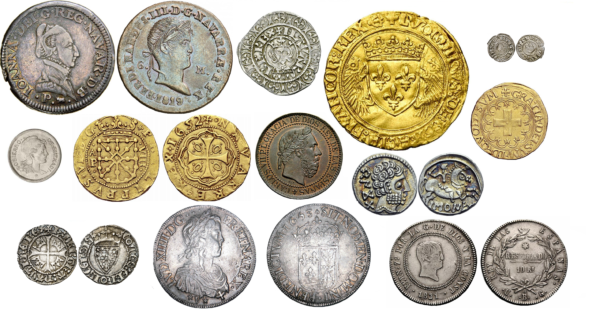As we saw in the previous entry, the coinage of Kings Catherine and John had two distinct periods, first one between 1487 and 1495 and the second between 1495 and 1512. The first coinage period ended at the end of 1493, as no coins were probably minted in 1494.
Regarding the first period we have already analyzed it in the previous section. We presented all the data regarding the types, purity, names, appearances and amounts of coins minted, provided by the documents kept in the Chamber of Comptos. Today we will talk about the second period, where we unfortunately have some gaps, but nevertheless know the types, purity, names and appearances of the coins minted. We have gaps in the coin accounts, since we lack the coinage accounts between 1494 and mid-1506. However, the coinage accounts between mid-1506 and 1512 have reached our days, within document 51 of box 167 of the Navarrese Archives. These coinage accounts, corresponding to the last coinage accounts of the united and sovereign kingdom were already known, but until now they had not been analyzed and published.
The coinage accounts will show us the monetary health of the kingdom before the conquest of the Ferdinand; there are some unexpected facts to be seen, as the kingdom was producing a larger amount of coins than many would expect when the conquest took place.
The monetary organization of this second coinage period is dictated by the coinage order issued in Pamplona on May 21th, 1495. This order is preserved in Document 2, Box 166 of the Archives of Navarre and has the following form and content:
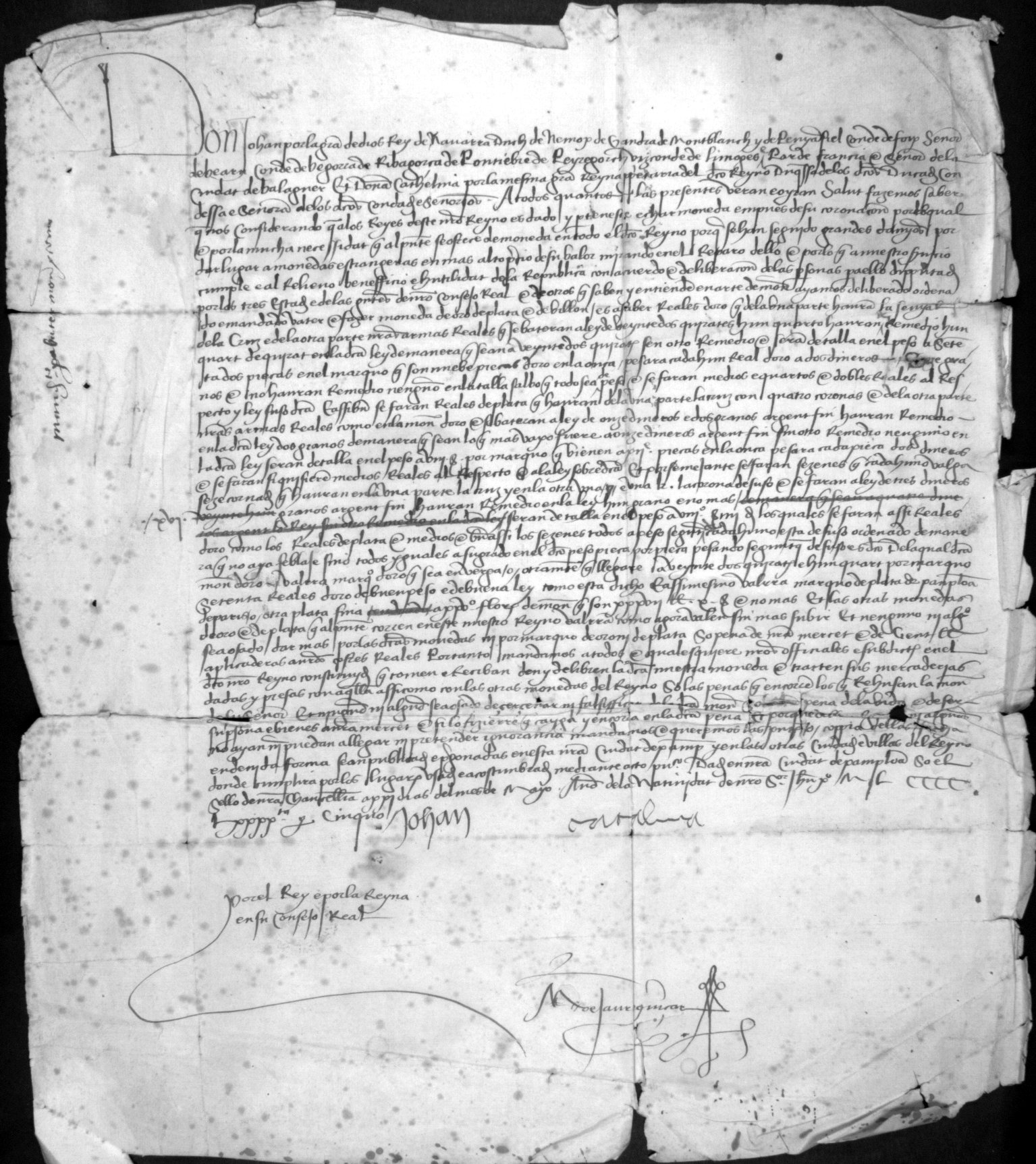
Courtesy of the General Archive of Navarre AGN, Box 166, Document 2
The content of this coinage ordinance is as follows:
Don Johan por la gra de dios Rey de Navarra Duchs de Nemours de Gandia de Montblanc y de Penyafiel Conde de Foyx Senor de Bearn Conde de Begorra de Ribaforza de Pontiebre de Peyregord bizconde de Limoges Par de Francia e Senor de la Ciudat de Balaguer et Dona Catherina Por la mesima gra Reyna propretaria del dcho Reyno Duquessa delos dchos ducados condesa e senora de los dchos condados e senorios. A todos quantos las presentes beran e oyran salut fazemos saber q nos considerando q alos Reyes desde ntro Reyno es dado y pertenese echar moneda empues de su coronamiento por el qual e porla mucha necessidar q al presente se ofrece de moneda en todo el dcho reyno porq se han seguydo grandes danyos por dar lugar a monedas estrangeras en mas alto precio de su balor myrando en el Reparo dello e porlo q anmexxxx cumple e al releno beneficio e utilidad dela Republica con acuerdo e deliberacion de las personas paello designadas por los tres estados e de las gentes de ntro consejo real e de otros q saben y entienden en arte de monedar ayamos deliberado ordenado e mandado bater e fazer moneda de oro, de plata e de billon. Es a saber Reales de oro q de la una parte haura la senyal de la cruz e de la otra parte ntras armas reales q se bateran a ley de beyntedos quirates bun quarto y auran remedio bun quart de quirat en la dcha ley de manera q sean a beyntidos quirats sin otro remedio e sera de talla en el peso a setentados piezas en el marquo que son nuebe piezas de oro en la onza. Se fara cada un Real de oro a dos dineros siete granos e ino hauran Remedio nenguno en la talla salbo que todo sea de peso. e se faran medios e quartos e Dobles Reales al Respecto y ley suso dcho. Y assi bien se faran Reales de plata que hauran de la una parte la cruz con cuatro coronas e de la otra parte nuestras armas reales como en la moneda de oro e se bateran a la ley de onze dineros e dos granos argent fin hauran remedio en la dcha ley dos granos de manera q sean lo que bajo fuere a onze dineros argent fin sin otro remedio nenguno en la dcha ley, seran de talla en el peso a 8 sueldos por marquo q bienen a XII piezas en la onza se fara cada pieza dos dineros e se faran si quisiere medios reales al respecto e a la ley sobre dcha. Et por semejante se faran sezenes q cada uno balga seze cornados que hauran en la una parte la cruz y en la otra una Y e una K. La razon a de suso q se faran a la ley de tres dineros (Strikethrough: beyntiun granos) XVI granos argent fin, hauran remedio en la ley un grano e no mas(struck through: de manera que sean a quatro dineros argent lo rey sin otro remedio en la dcha ley), seran de talla en el peso a VIII Sueldos IIII dineros los quales se faran assi Reales doro como los Reales de plata e medios e bien assi los sezenes todos a peso segun cada uno esta desuso ordenado de manera que no aya feblaje sino todos iguales a figurado en el dcho peso pieza por pieza pesando segun lo que de suso se ha dicho. E a lo qual dcha moneda de oro batera marquo de oro q sea en berga o otrambe que llegare a beintidos carates e un quart por marquo setenta reales de oro de buen peso e de buena ley como esta dicho. E assimismo batera marquo de plata de pamplona, de Paris o orza plata fria a XXV florines de moneda q son XXXVII Libras X Sueldos e no mas. Et las otras monedas de oro e de plata q al presente corren en este nuestro reyno baldra como agora balen sin mas subir et nenguno ni alguno sea osado dar mas por las dchas monedas ny por marquo de oro ny de plata sopena de sua mercat e de Gens ap tiraderas anrdo presentes reales. Portanto mandamos atodos e qualesquiere ntros officiales e subdictos en el dcho ntro Reyno confirmydos q tomen e reciban den y delibren la dcha mesma moneda e tracten sus mercaderyas dadas y presas con aquella assicomo con las otras monedas del Reyno sota las penas q encorcen los que rehusan la moneda de su senor. Et nynguno ny alguno sea osado de cercenar ny falsyficar dela dcha moneda so pena delabrada e desuplona ebrenes contra mercet e si lo fiziere q cayga y encorca en la dcha pena. Et porquedela ny alguno no ayan ny puedan allegar ny pretender ignorancia mandamos e queremos las presentes soppra leydas en devyda forma sean publicas e pregonadas en esta ntra ciudad de Pamplona y en las otras ciudades e villas del Reyno donde xxxxx por los lugares visados e acostumbrados mediante acto publico. Dado en ntra ciudat de Pamplona sota el sello de ntra Chancelleria a XXI dias del mes de Mayo Ano dela Nacimiento de ntro Sor Jxto Mil CCCCLXXXX y Cinquo.
Johan, Catalina
por el Rey e por la Reyna en su Consejo Real -> Martin de Jaureguizar
King and queen were crowned in the Cathedral of Santa María in Pamplona in January 1494 and, with these kind of ordinances, they began a new ruling era. This era was based on a new monetary policy, initiated by and for the territories of Navarre, which aimed to end the usage of foreign coins. It also had the secondary objective of making it easier to exchange certain coins minted in the Lordship of Bearn. The new monetary structure included all denominations of coins, whether gold, silver or billon.
Having analyzed the ordinance, we would be presented with the following summary table of the structure of the monetary system. The names and characteristics referred by the documents have been used:
|
Name |
Value |
Nominal Law (Fineness) |
Number of Coins / Rough Mark |
Nominal Weight (gr) |
Legal Fineness Remedy/Tolerance |
Legal Weight Remedy/Tolerance |
|
Double Gold Real – Unknown |
106.66 Gros – 80 Tarjas |
22.25 carats - 927 Mils |
36 |
6.8g |
0.25 Carat, 917 Mils with Remedy |
No remedy |
|
Gold Real 1495-1512 |
53.33 Gros – 40 Tarjas |
22.25 carats - 927 Mils |
72 |
3.40g |
0.25 Carat, 917 Mils with Remedy |
No remedy |
|
Half Gold Real 1495-1506 |
26,665 Gros – 20 Tarjas |
22.25 carats - 927 Mils |
144 |
1.7g |
0.25 Carat, 917 Mils with Remedy |
No remedy |
|
Quarter Gold Real 1495-1506 |
13.3325 Gros – 10 Tarjas |
22.25 carats - 927 Mils |
288 |
0.85g |
0.25 Carat, 917 Mils with Remedy |
No remedy |
|
Silver Real 1495-1506 |
4 Gros – 3 Tarjas – 48 Cornados |
11 Deniers 2 grains – 924 Mils |
96 |
2.55g |
2 grains, 917 Mils with Remedy |
A piece in a rough mark? |
|
Half Silver Real – Unknown |
2 Gros -1.5 Tarjas – 24 Cornados |
11 Deniers 2 grains – 924 Mils |
192 |
1,275g |
2 grains, 917 Mils with Remedy |
Two pieces in a rough mark?? |
|
Tarja – Sezena 1495-1512 |
16 cornados – 32 deniers – 1.33 Gros |
3 Deniers 16 grains – 305 Mils |
100 |
2.44g |
1 Grain, 302 Mils with Remedy |
One piece in a rough mark?? Or maybe four? |
|
Cornado 1487-1512 |
2 Black Deniers |
11 Grains – 38 Mils |
256 |
0,95 |
1 Grain, 34.72 mils with remedy |
3-4 Pieces in a rough ounce (24-32 Pieces in a mark) |
|
Negretes - Black Money – Half Cornados 1487-1512 |
A Denier |
6 Grains – 20.8 mils |
352 |
0,69 |
1 Grain, 17.36 mils with remedy |
4 Pieces in a rough ounce (32 Pieces in a rough mark) |
The monetary organization and the equivalence of pieces in the Kingdom of Navarre between 1495 and 1512
When I created the summary in the table above, in addition to the mentioned document, I used other documents, coin databases and different bibliographies. After analyzing all these sources, we can deduct that:
- Up to this date, we have no knowledge of double gold reales or half silver reales. They may have been minted, but no known specimens have survived to this day.
- No coinage accounts of the period between 1494 and 1506 seem to have survived.
- Coinage accounts between the years 1506 to 1512 have made it to our days, and we can confirm that during these years, whole gold reales, tarjas, cornados and negretes or black moneys were minted. Double gold reales, halves or quarters, and whole or half silver reales were not minted during these years.
- Since we are aware of specimens of gold half and quarter reales and silver whole reales, we can conclude that these were only minted between 1495 and 1506.
- Since the 1495 coinage ordinance does not mention the characteristics of the cornados and negretes, we can conclude that they continued to be minted with the previous weight and silver content. This statement would be confirmed by Document 28 of Box 164 of the Navarrese Archives (dating between 1492 and 1495).
- The passage that provides us the value of gold and silver coins does not appear in the ordinance, but it does in the Document 28 of Box 164 of the Navarrese Archives, which was also mentioned in the entry regarding the Bearnaise monetary system. On Page 6 (Verso 6) of this document, we are shown what looks like a draft of the ordinance of 1495:
"Moneda de oro e de plata e de billon en este dcho Reyno por la cantidad e probecho y dello se seguira e assin que en el Reyno se falle moneda de aquel. La qual dcha moneda sea fecha e batida de la ley talla forma e orden contenyda en las ordenanzas just aprobadas.
Primeramente se faran Reales medios Reales e quartos de Reales doro a la ley de XXII quilates seran LXXII en marquo pesara cada pieza de oro a II dineros XIIII granos por lo qual balera la pieza de oro delos dchos Reales doro cada una quarenta tarjas o sezenes de la moneda blanca q de bajo contiene entpues mandamiento e fazer seabien medios reales al dcho respecto e quarto de Reales tan bien algunos por q aya de todas piezas e bien assi dobles reales de pro, a doble peso de oro y ala ley mesma de los dchos Reales de oro y baleran al respecto el doble de los dchos Reales doro.
(the next passage has been struck through)
No les menos se faran/bateran Reales e medios Reales de plata a la ley de XI dineros II granos de peso de II dineros argent fin, abran remedio en la ley a II granos, de peso de dos dineros, dela buna parte haura buna cruz con quatro coronas y de la otra las sobre dcha armas, balera cada Real tres sezenas e al respecto Reales de medio como dcho es.
no sea osado de cercenar ni falsificar de la dcha moneda so pena de la vida e de ser su persona e bienes a ntra merced e silo fiziere q encorra enla dcha pena. Et por sy dello alguno ny algudo no ayan ny puedan allegar ny pretender ignorancia mandamos e queremos las sean publicada e pregonada en esta ntra ciudad de Pan y en las otras ciudades e billas del Reyno donde cumplira por los lugares usados e acostumbrados mediante carto prente. Dado en ntra ciudad de Pamp con el sello de ntra chanc a XXI dias del mes de mayo Ano MCCCCLXXXXV."
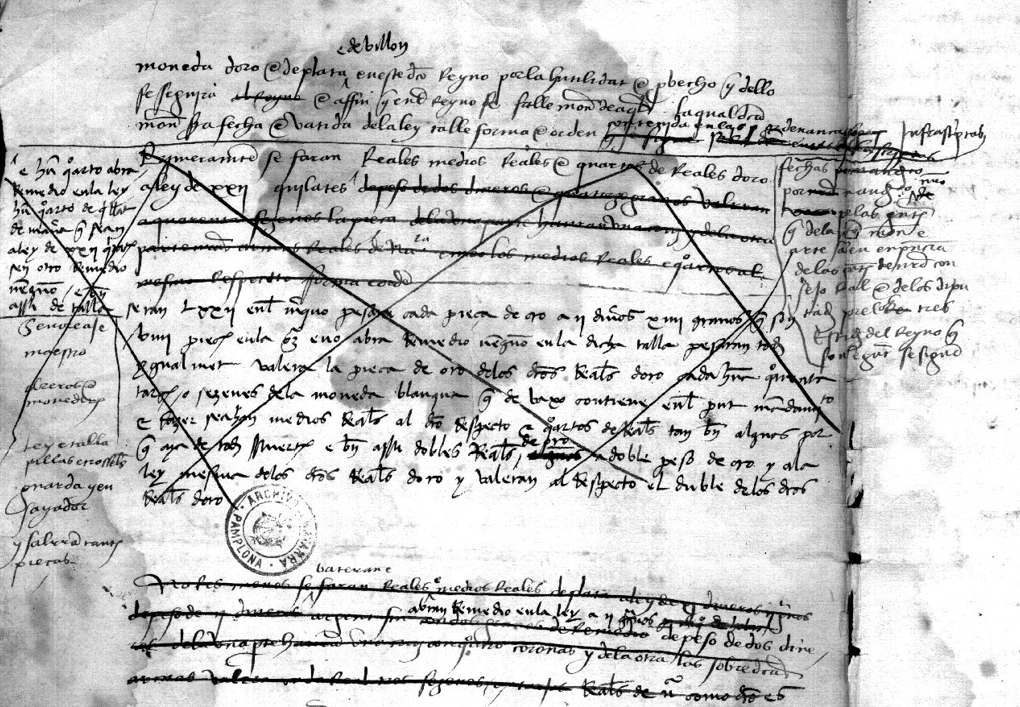
Courtesy of the General Archive of Navarre AGN, Box 164, Document 28, Sub-entry in Page 12 (Verso 6)
This 28th Document of box 164 in the Navarrese archives is an absolute treasure; it seems to be a draft or preparation of the coinage decree published on May 21st, 1495. Out of this document, it is deduced that each gold real should have the equivalent of 40 sézenas or tarjas. Similarly, a silver real had the equivalent of 3 sézenas, which equated to the value of 4 groses. At this time, the groses were already a monetary accounting unit, and from then on, they were worth 12 cornados for the rest of the history of Navarrese coinage. The tarja or sézena, on the other hand, received the value of 16 cornados.
Looking at the content of the above mentioned documents, I learned another interesting thing. Although the tarja or sezenas were issued with a nominal silver content of 3 deniers and 16 grains, the original intention was to use a silver content of 3 deniers and 21 grains. The passage that shows the silver content of that original intention is even crossed out in the published official ordinance, reflecting a last-minute change.
Likewise, the fineness of silver was expressed in two different ways in the ordinance, according to the so-called “argent fin” and “argent lo rey”:
"La razon a de suso q se fara a la ley de tres dineros (struck through: beyntiun granos) XVI granos argent fin, hauran remedio en la ley un grano e no mas(struck through: de manera que sean a quatro dineros argent lo rey sin otro remedio en la dcha ley)"
In the Kingdom of France, in the 15th and 16th centuries, the difference in silver purity between “argent fin” and “argent le roy” was as follows:
Argent fin: would be the purest silver available, with a fineness of approximately 958 mils (% 95.8 silver), or 11 deniers and 12 grains at the time.
Argent le roy: It was the silver used to make royal currency and had a lower purity, generally between 923 and 937 mils (% 92.3 – % 93.7 silver) or about 11 deniers and 6 grains of the time.
In my calculations I assigned a silver purity of 100% to the so-called argent fin, which was unreachable with the technology of the time; therefore, I produce a small error in the calculations but for the current analysis it is an easier and more general reference to use that silver purity value of 100% as a basis.
This draft 28th document of Box 164 provides us additional datapoints. For example, the law and weight of the Cornados and the negretes (black money):
„La qual sobre dicha obra de cornados sera a ley de onze granos por marquo de obra con bun grano de Remedio en la dcha ley e sera de talla a treinta seis cornados por onza e assi hubiese feblaje sota este peso sera el dicho feblaje pa la senorya assi bien en los remedios de la ley si los hubiere
Assi bien sepide fazer negretes los quales se faran a la ley de seys granos abra remedio a bun grano por marquo en la dcha ley e sera de talla al peso a doze quadernas por onza q seran quarenta ocho negretes por onza e si fablaje hubiese nenguna sera pa la senorya assi bien el Remedio de grueso Palynbres e en los dichos negretes".
Or regarding the equivalence of a gold real to 53.33 groses or 40 sezenes:
"Moneda de oro e de plata e de billon en este dcho Reyno por la cantidad e probecho y dello se seguira e assin que en el Reyno se falle moneda de aquel. La qual dcha moneda sea fecha e batida de la ley talla forma e orden contenyda en las ordenanzas just aprobadas.
Primeramente se faran Reales medios Reales e quartos de Reales doro a la ley de XXII quilates seran LXXII en marquo pesara cada pieza de oro a II dineros XIIII granos por lo qual balera la pieza de oro delos dchos Reales doro cada una quarenta tarjas o sezenes de la moneda blanca"
"Item habra la senoria pa su senoriales e pa pagar los gages acostumbrados pillas et troseles buna pieza de oro por marquo de obra monedada —————-> V libras VI sueldos VIII diners"These five pounds, six shillings, and eight deniers give us the exact value of 40 tarjas or 53 groses and 1/3 a piece."
It also provides information on the high-ranking coinage officials who participated in the preparation of the coinage law:
„Don Johan et Dona Catherina. A los amados ntros Martin de Aoyz, mayor de edad maestro (y en su ausencia a Berenguer de Ayoz, menor de edad), Martin Cruzat general, Pedro de Caparroso guarda e Miguel de Espinal Ensayador de nuestra moneda real e a cargo de vos. Salut fazemos vos saber q nos con acuerdo e consentimiento de las personas paello dispuestas por los tres estados deste nuestro reyno e deliberacion delas gentes de nuestro consejo real e de personas assi mercaderes como otras personas y ententidos q saben en arte de moneda por lo que anter fruyro simple e bien de la cosa publica…“
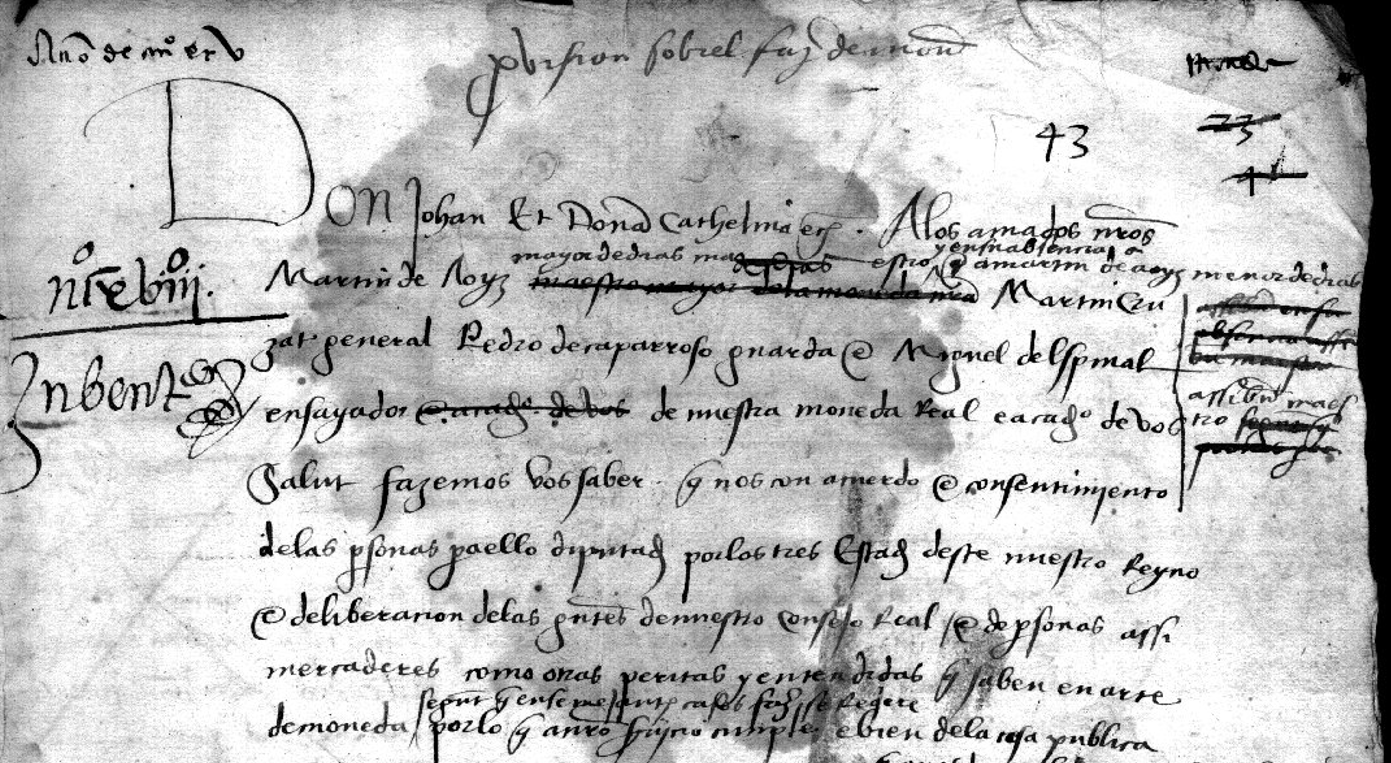
Courtesy of the General Archive of Navarre AGN, Box 164, Document 28, Sub-entry of Page 13 (6 Recto)
The contents in this document, can be dated between 1492 and 1495. Some of the writings seem to date from the time of the meeting of the estates in 1492 meeting which were held in Estella. Others bear the same date as the coinage law of 1495. According to the above, we can see that the same people who were involved in the first coinage of Francis Febus and Catherine and Juan are also present in the preparation of the second coinage law:
- Martin d'Aoyz, Mint Master. The first minting document of Queen Blanca dated in 1428 already mentions a merchant named Martin d'Aoyz and as we can see, the same family remained involved in minting coins even throughout the 16th century. Belenguer d'Aoyz, His son took over his father's position during 1491, as his first mention appears in July 1491. After the conquest of Navarre, during the reign of King Fernando, this son continued to be head of the mint.
- Pedro Marzilla de Caparroso, He was the guard of coinage in the royal tower He was the general guard of the minting activities in the entire Kingdom of Navarre. At some point, he left his position between the years 1494 and 1506. The last mention of Pedro Marzilla in the documents of the Comptos is in 1517; since 1515 he had been mayor of Pamplona. Document 30 of Box 167 of the Navarrese Archives, preserves a royal order from 1503. This order names Johan de Aguyrreguy for the role of counter role (or counterguard), which is the royal official who had supervisory functions of the guard and the mint master) , where this Johan should have written the accounts of the coins minted in the royal tower and collected the seigniorage taxes. I have no information about the accounts of this so-called Agirregi, the coinage accounts that were started in 1506 by Johan Miguel Garceys were naming him as guard and as the person in charge of the minting. The minting orders of King Ferdinand in 1513 were mentioning a named Juan Miguel Garces de Cascante as "guarda". Both of them are probably the same guard.
- Miguel de Espinal, essayer. From July 1493 onwards, „Miguel d'Espinal el Jove, minor of age,“ the son of the previous one is mentioned. Miguel de Espinal received the position of lifetime Master of Finance of the Royal Court in 1495. An order written in Pau on September 10th 1510, orders the payment of his salary to the assayer Miguel Espinal (who must have been the younger son). The coinage orders of King Fernando in 1513 mention a so named Luis Cruzat as general of coinage and essayer.
- Martin Cruzat general of coinage. His duties seem to have been related to the control of other senior staff. He seems to have been the father of Luis Cruzat who as said before, in the orders of King Fernando of 1513 is mentioned as coinage general and essayer.
If we look at the high staff responsible for coinage activities, we can notice a significant continuity between the periods of Francis Phoebus, Catherine and even the later King Fernando.
After all the performed studies, we can make a summary of the coinage systems of these three reigns. Let's start with the gold coins.
Catherine's gold reales maintained the same weight as the previous "nabarro" coins, with 72 coins being struck per rough mark. In terms of gold content, they lost another half a carat when compared with these "nabarro" coins (the "nabarro" coins had also lost half a carat when compared with the Ducats of Francis Febo). The ducats of Ferdinand which were struck after the Conquest were equated with the Castilian standard, after abandoning the local Navarrese standard.
The exchange payments when striking Catherine's reales was once again simple. Those who brought gold received 70 reales, one piece was for the seigniorage tax and the last piece was for the minting expenses.
|
Name |
Value |
Nominal Law (Fineness) |
Number of Coins / Rough Mark |
Nominal Weight (gr) |
Legal Fineness Remedy/Tolerance |
Legal Weight Remedy/Tolerance |
|
Old Gold Ducats 1482-1486 (Fr. Febo) |
46 / 47 / 48 Gross |
23 carats – 958 mils |
72 |
3.40g |
No remedy |
No remedy |
|
Golden Nabarros 1487-1493 (Catherine) |
53 Gross |
22.5 carats – 937.5 mils |
72 |
3.40g |
No remedy |
No remedy |
|
Golden Reales 1495-1512 (Catherine) |
53.33 Gross – 40 Tarja |
22.25 carats - 927 Mils |
72 |
3.40g |
0.25 Carat, 917 Mils with Remedy |
No remedy |
|
Fernando's Gold Reales/Ducats from 1513 onwards |
62.5 Gros – 375 maravedis |
23.75 carats -989 Mils |
70 |
3.5g |
No remedy |
No remedy |
|
Double Golden Reales – (Catalina) Unknown |
106.66 Gros – 80 Tarja |
22.25 carats - 927 Mils |
36 |
6.8g |
0.25 Carat, 917 Mils with Remedy |
No remedy |
|
Ferdinand's Double Gold Reales/Ducats from 1513 onwards |
125 Gros – 750 Maravedi |
23.75 carats -989 Mils |
35 |
7.0g |
No remedy |
No remedy |
|
Half Gold-Reales 1495-1506 (Catherine) |
26,665 Gros – 20 Tarja |
22.25 carats - 927 Mils |
144 |
1.7g |
0.25 Carat, 917 Mils with Remedy |
No remedy |
|
Ferdinand's Half Gold Reales/Ducats from 1513 onwards – Unknown |
31.25 Gros – 187.5 Maravedi |
23.75 carats -989 Mils |
140 |
1.75g |
No remedy |
No remedy |
|
Gold Real Quarters 1495-1506 (Catherine) |
13.3325 Gros. 10 Tarja |
22.25 carats - 927 Mils |
288 |
0.85g |
0.25 Carat, 917 Mils with Remedy |
No remedy |
Characteristics and equivalence of gold coins specified in the coinage orders of the reigns of Francis Phoebus, Catherine and Ferdinand (1481-1513)
If we look at the silver mintage, rich-content silver coins were once again minted, known as silver reales, with a silver content of over 900 mils. If we look at their silver content, although the content was slightly lower than the reales minted in Castile, they were considerably lower in weight, around 0.9 grams lower. This Castilian silver standard prevailed in the coins of Fernando, from 1512 onwards.
The price of a fine silver mark was 25 florins or 37 pounds and 10 sous according to the minting order, where each florin was already used as an accounting currency unit, with a value of 1.5 pounds.
|
Name |
Value |
Nominal Law (Fineness) |
Number of Coins / Rough Mark |
Nominal Weight (gr) |
Legal Fineness Remedy/Tolerance |
Legal Weight Remedy/Tolerance |
|
Silver Real 1495-1506 (Catherine) |
4 Gros – 48 Cornados |
11 Deniers 2 grains – 924 Mils |
96 |
2.55g |
2 grains, 917 Mils with Remedy |
A piece in one rough mark?? |
|
Fernando's Silver Real from 1513 – |
5 2/3 Gros – 68 cornado – 34 Maravedi |
11 Deniers 4 grains – 930 Mils |
72 |
3.40g |
?? |
?? |
|
Silver Half Real 1495-1506 (Catherine) – Unknown |
2 Gros – 24 Cornados |
11 Deniers 2 grains – 924 Mils |
192 |
1,275g |
2 grains, 917 Mils with Remedy |
Two pieces in a rough mark?? |
|
Silver half Real of Fernando from 1513 onwards |
2.83 Gros-34 Cornado – 17 Maravedi |
11 Deniers 4 grains – 930 Mils |
144 |
1.7g |
?? |
?? |
|
Silver Real quarter of Fernando from 1513 – Unknown |
1.41 Gros-17 Cornado – 8.5 Maravedi |
11 Deniers 4 grains – 930 Mils |
288 |
0.85g |
?? |
?? |
Characteristics and equivalence of silver coins specified in the coinage orders of the reigns of Catherine and Ferdinand (1495-1513)
And finally, we will finish by looking at the billion coins. The comparison between Francis Febo's groses and Catherine's tarjas is quite significant.
|
Name |
Value |
Nominal Law (Fineness) |
Number of Coins / Rough Mark |
Nominal Weight (gr) |
Legal Fineness Remedy/Tolerance |
Legal Weight Remedy/Tolerance |
|
Gross 1481-1484 (F. Febus) |
16 Cornado – 32 deniers |
4 deniers 3 grains – 343 Mils |
88 |
2,78 |
3 Grains, 333 Mils with remedy |
A Piece in a Mark |
|
Tarja – Sezena 1495-1512 (Catherine) |
16 Cornado – 32 deniers |
3 Deniers 16 grains – 305 Mils |
100 |
2,44 |
1 Grain, 302 Mils with Remedy |
One Piece in a rough Mark?? Or Four Pieces?? |
|
Half Gros 1481-1484 (F. Febo) |
8 Cornados – 16 deniers |
4 deniers 3 grains – 343 Mils |
176 |
1,39 |
3 Grains, 333 Mils with remedy |
Two Pieces in a Mark |
|
Cornado 1482-1485 (F. Febo) |
2 Black Deniers |
15 Grains – 50 Mils |
256 |
0,95 |
One grain, 48.61 Mils with the remedy |
2 Pieces in a Rough Ounce (16 Pieces in a rough Mark) |
|
Cornado 1487-1512 (Catherine) |
2 Black Deniers |
11 Grains – 38 Mils |
256 |
0,95 |
A grain, 34.72 Mils with remedy |
3-4 Pieces in a rough ounce (24-32 Pieces in a mark) |
|
The Cornados of Pernando from 1513 onwards |
2 Black Money – A Castilian Blanca |
7 Grains – 24 Mils |
240 |
1.01 grams |
?? |
?? |
|
Black Money – Half Cornados 1483-1485 (F. Febo) |
A Denier |
8 Grains – 27 Mils |
352 |
0,69 |
A grain, 24 Mils Aprox. with remedy |
4 Pieces in a rough ounce (32 Pieces in a rough mark) |
|
Black Money – Half Cornados 1487-1512 (Catherine) |
A Denier |
6 Grains – 20.8 mils |
352 |
0,69 |
A grain, 17.36 Mils with remedy |
4 Pieces in a rough ounce (32 Pieces in a rough mark) |
|
Fernando's Black Money from 1513 onwards |
A Denier |
3.5 Grains – 12 Mils |
352 |
0,69 |
?? |
?? |
Characteristics and equivalence of the billon coins specified in the coinage orders of the reigns of Francis Phoebus, Catherine and Ferdinand (1481-1513)
These three summary tables are quite interesting. Catherine lowered the value of the cornado, which was the basis of the monetary system, at the beginning of her reign, but it remained constant thereafter. The greatest contribution of her reign was the creation of the tarja or sezen, along with the lavish gold coinage.
Fernando the deceiver, however, devalued the cornado once again, the basis of the monetary system, when he equated it with the Castilian blanca coin in 1513. Two cornados were equated to one Castilian maravedí and the weight, metal content and value of all silver and gold coins were equal to those of Castile. From then on, the equivalence of these high-value coins in grosses or tarjas was completely unmatched, without a significant easy to match value. As a result, no more tarjas were minted for real in the future. But these are matters for another entry.
Before we look at the coinage accounts, let's see what these coins created by the coinage law of 1495 looked like. Let's start with the gold coins.
We can differentiate three different types of whole gold reales coins. All types feature the coat of arms of the Evreux royal family on the obverse and a Christian Templar cross with lobes on the reverse. The most numerous subtype features legends that fill the entire circumference of the obverse of the coin:
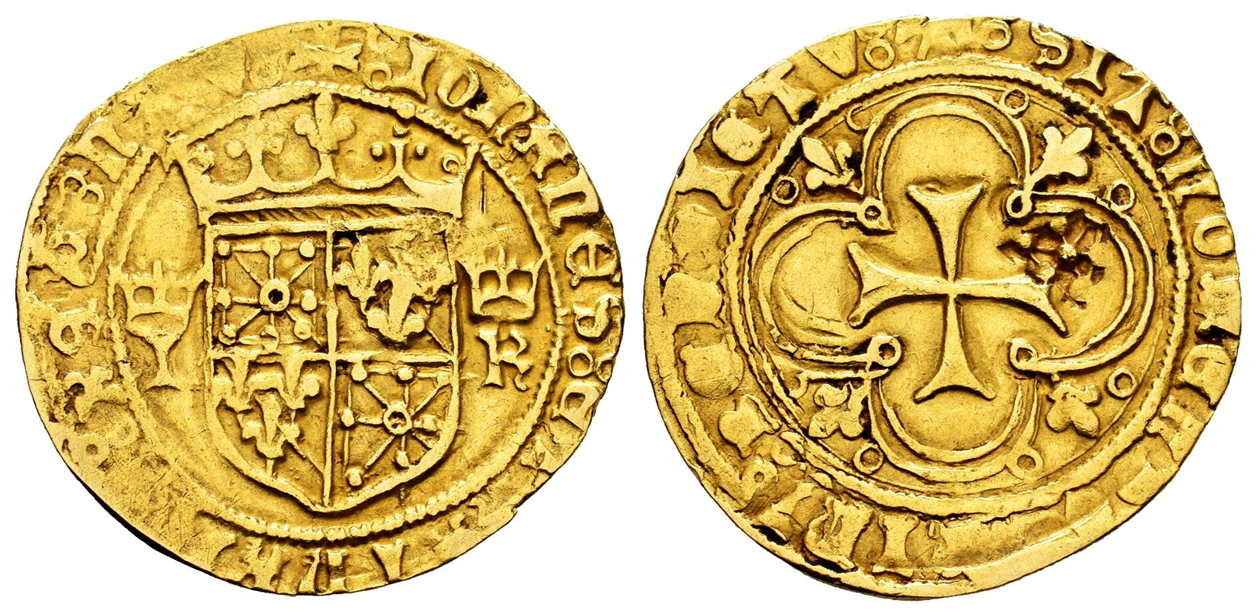
Gold real minted in the name of Catherine of Navarre (1483-1517) and John (1484-1516) – 3.27 gr – 22 carat content (917 Mils) – Principe de Viana Collection, Huntington Collection specimen (HSA-8018) – EUR 6,750 Auction price – 1524 re-stamp on the reverse
Obverse: IOHANES : ET : KATHRI(NA) : REG : NAV :
Reverse: SIT:NOMEN:DOMINI:BENEDICTV
Tauler & Fau Auctions, Auction 144, Lot 1317 24.06.2024
As mentioned, these gold coins of this first group are the most numerous type of real. They can be found in museums and auctions around the world, and although they are not common, they are more numerous than the "nabarros" struck in the first minting period of the kings Catherine and John. As a result, many variants of legends have been identified and those interested in learning more about them can refer to the works of experts Ricardo Ros or Miguel Ibañez. Here is another specimen bequeathed to the Fritzwilliam Museum in Cambridge by the expert Philip Grierson:
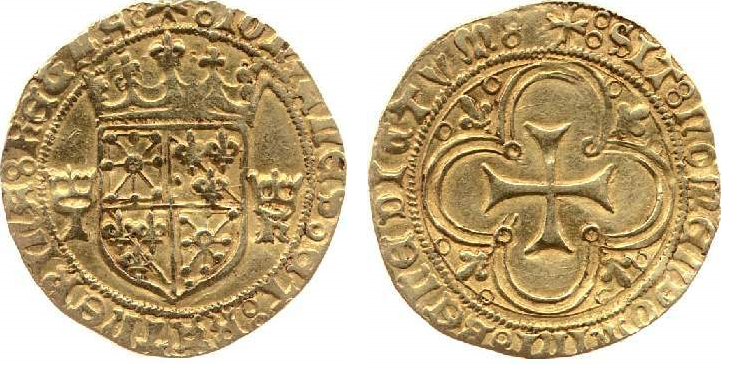
Gold coin minted in the name of Catherine of Navarre (1483-1517) and John (1484-1516) – 22 carat content (917 Mils) – 3.36gr – 22mm – Fritzwilliam Museum, Cambridge – Philip Grierson bequest
Obverse: IOHANES: ET: KATHERINA:REGES
Reverse: SIT:NOMEN:DOMINI:BENEDICTVM
Fritzwilliam Museum, Object 10097-2006
As a curiosity, here is another real coin from this first group in which Catherine's K letter appears on the left side of the coat of arms, in a privileged position. Women were often given a secondary role in those times, but fortunately, this coin puts Catherine in her place, as the rightful and legitimate Queen of Navarre.
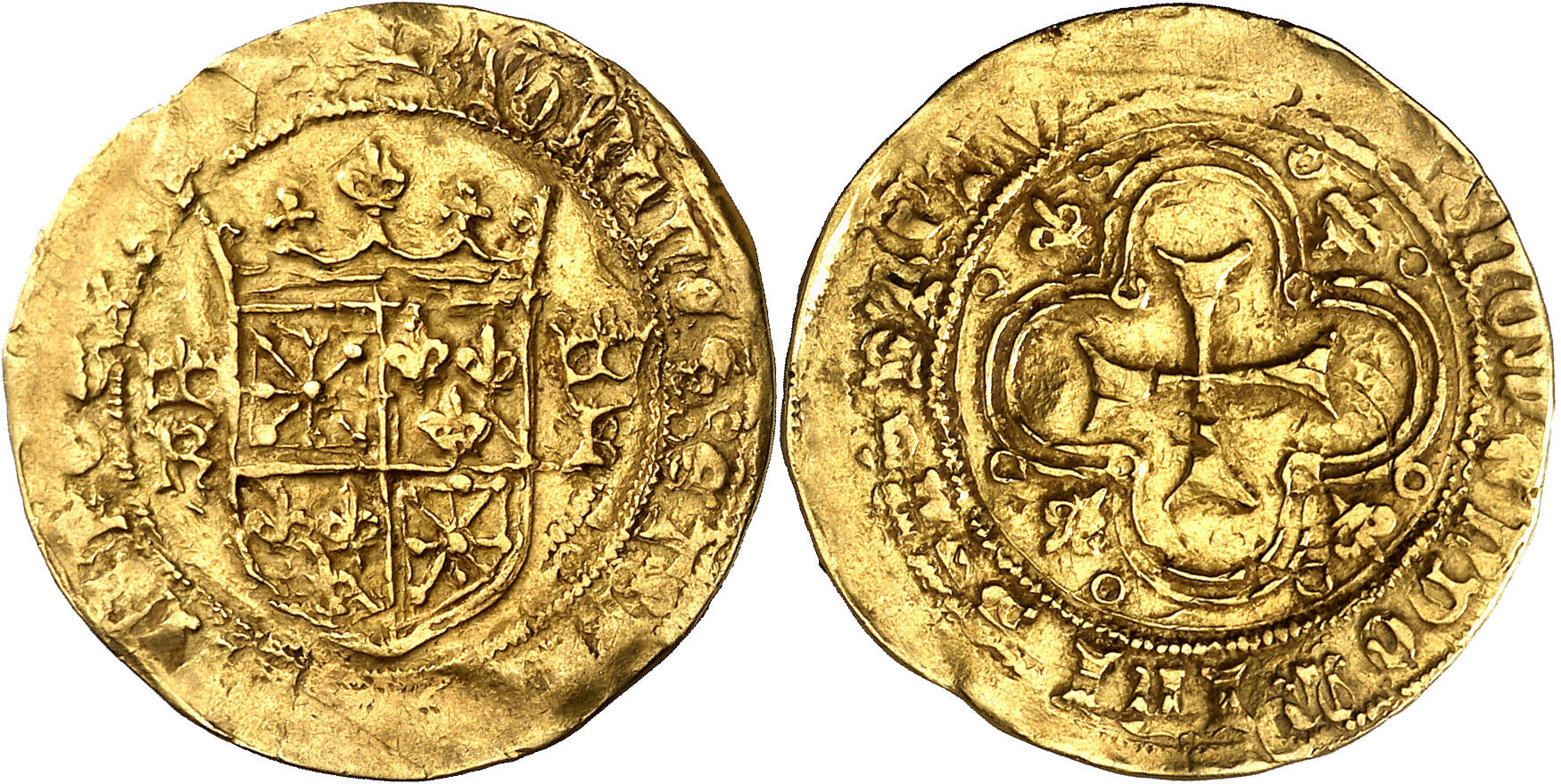
Gold coin minted in the name of Kings Catherine of Navarre (1483-1517) and John (1484-1516) – 22 carat content (917 Mils) – 3.33gr – K and I letters on the sides of the coat of arms – €4400 Auction Price
Obverse: IOHANES: ET: KATHERINA: REGES: NAVR?
Reverse: SIT:NOMEN:DOMINI:BENEDICTVM?
Aureo & Calicó, Auction 386, Lot 2209 17.03.2022
In the case of the second group type of reales, the crown above the coat of arms of the Evreux family interrupts the legends on the obverse. The first subset of this second set has crowned I and K on the sides of the coat of arms. I am only aware of two specimens of this second group:
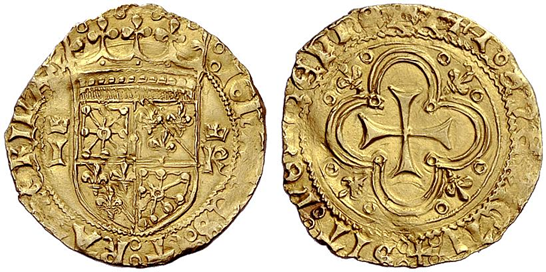
Gold coin minted in the name of Catherine of Navarre (1483-1517) and John (1484-1516) – 22 carat fineness (917 Mils) – Huntington Collection specimen (HSA-8020)
Obverse: IOHANES: ET: KATHERINA.
Reverse: SIT:NOMEN:DOMINI:BENEDICTV
Jesús Vico, Auction 131, Lot 885 09.10.2012
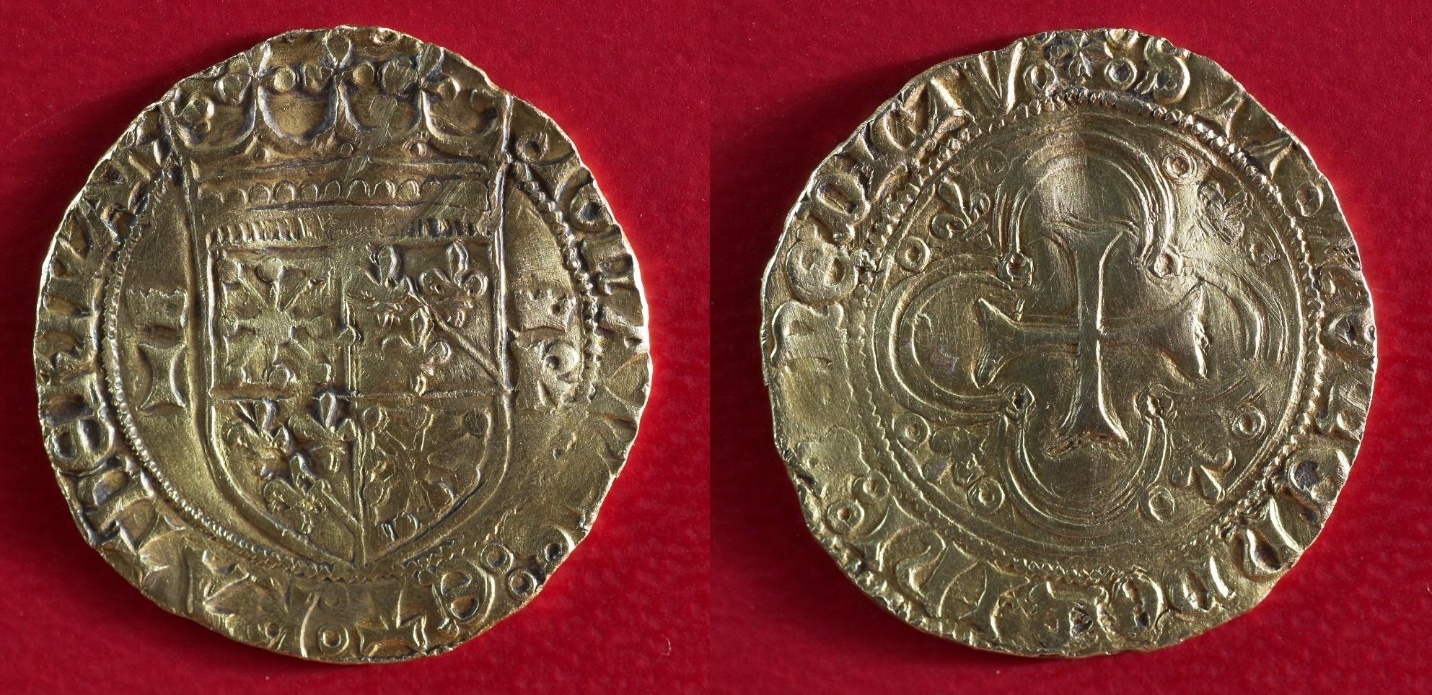
Gold coin minted in the name of Kings Catherine of Navarre (1483-1517) and John (1484-1516) – 22 carat content (917 Mils) – 3.30gr – 23mm – Museum of Navarre
Obverse: IOHANES: ET: KATHERINA.
Reverse: SIT:NOMEN:DOMINI:BENEDICTV
Museum of Navarre object N004846
The third subset, which has only one known specimen, differs from the second subset by the absence of the letters I and K next to the coat of arms. This single specimen is kept in the Bibliothèque nationale de France and also lacks the pair of bezants that usually appear next to the lobes and lilies on the reverse. It also has a completely different script, with Latin letters instead of the Gothic ones seen in the previous specimens, which are closer to those currently in use today and are evolved from the gothic ones.
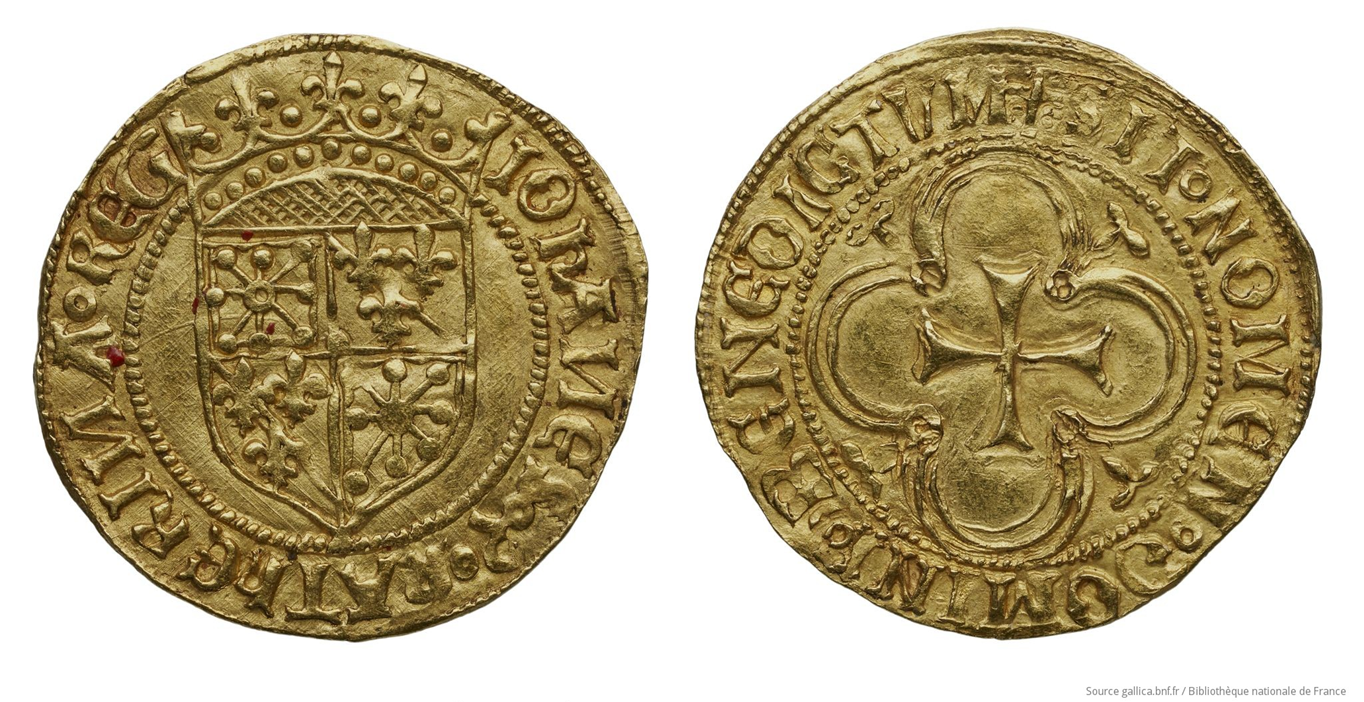
Gold real minted in the name of Catherine of Navarre (1483-1517) and John (1484-1516) – 22 carat content (917 Mils) – 3.38gr – National Library of France
Obverse: IOHANES: Z: KATHERINA.REG
Reverse: SIT:NOMEN:DOMINI:BENEDICTVM
National Library of France (BNF)
The obverse of this third group can be said to be derived from the obverse of the "nabarro" coins of the first coinage period. Here is a comparison between this piece of the French National Library and the obverse of the "nabarro" coin exhibited in the Santa Clara Museum in Murcia:
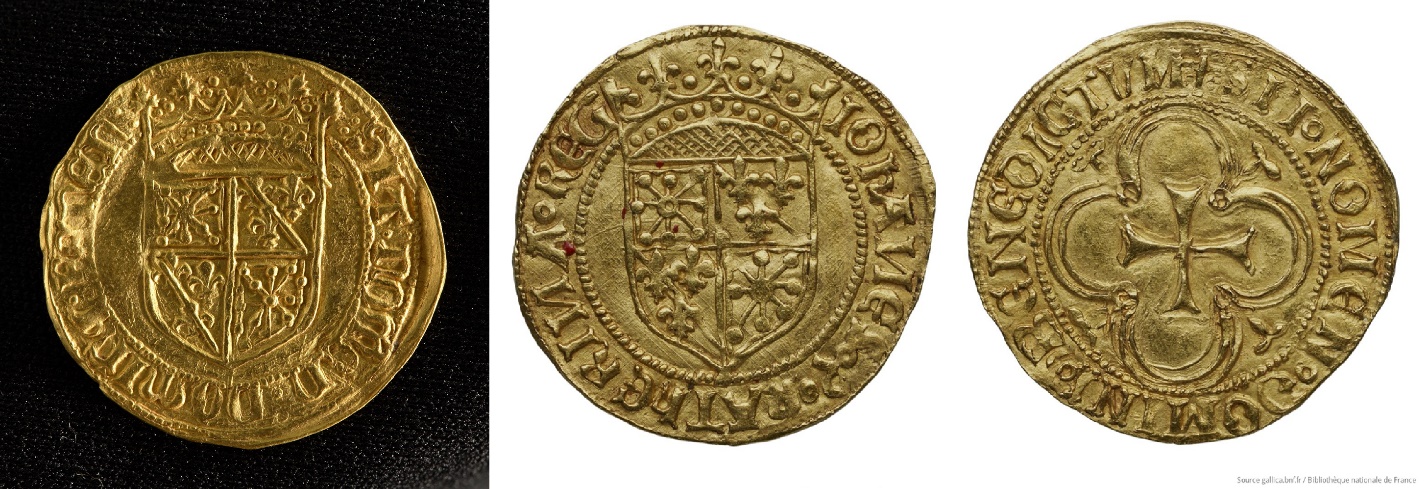
Comparison between the "nabarro" found in Plaza Yesqueros and the exemplar at the BNF in Paris
This Paris exemplar deserves a closer examination, especially regarding the development of the script. The more developed script also appears on some of the few known silver reales, as the following comparison shows. Let us check how the Z, N and M letters look in the following comparisons and we will notice that they have significant similarities: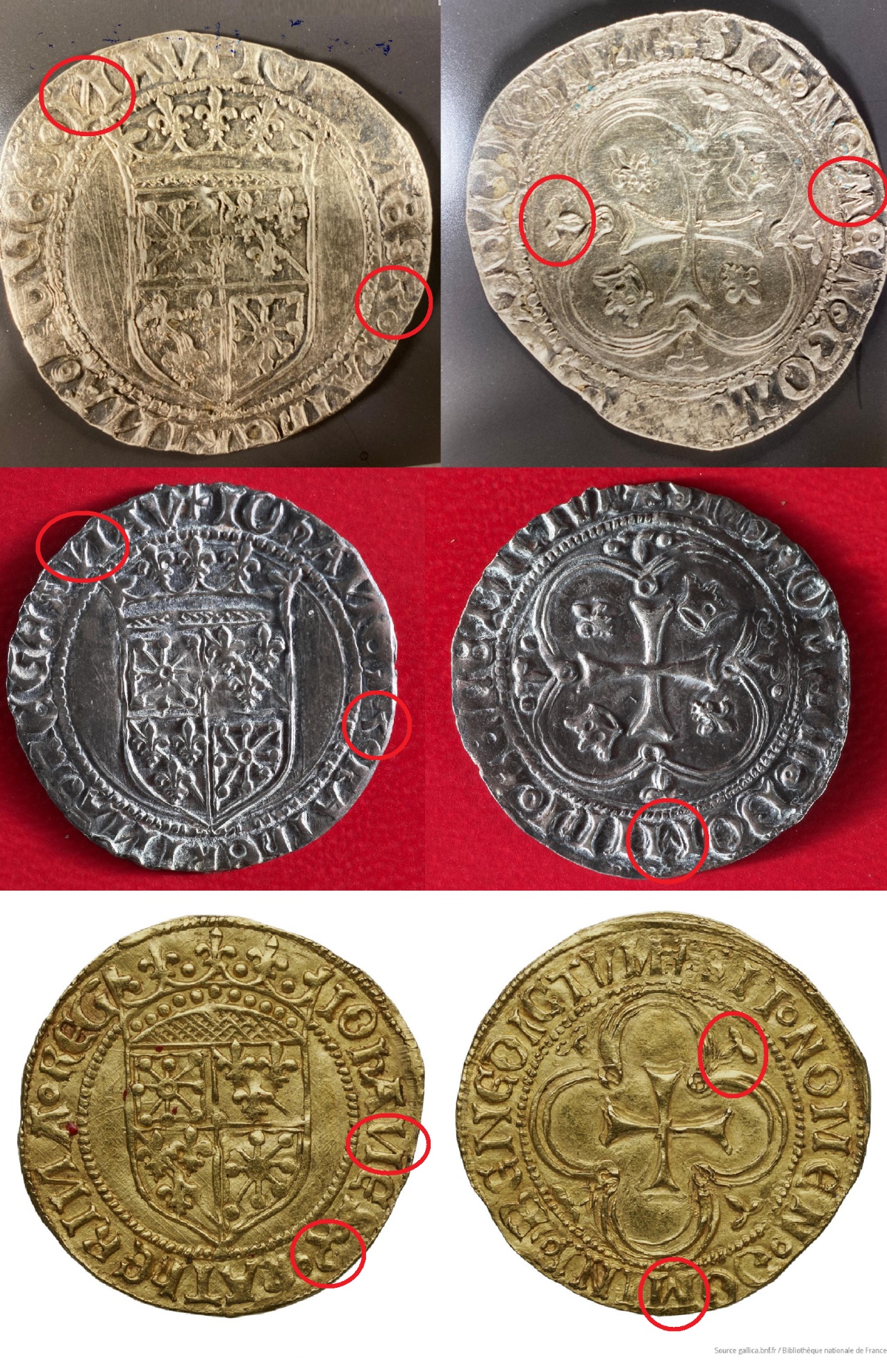
Comparison between two of the known silver reales and the Paris gold real
Since we have started talking about silver reales, let's look at the four specimens of these reales that I am aware of. Let's first remember what the coinage law refers regarding these silver coins:
„Y assi bien se fara Reales de plata que hauran de la una parte la cruz con cuatro coronas e de la otra parte nuestras armas reales como en la moneda de oro e se bateran a la ley de onze dineros e dos granos argent fin hauran remedio en la dcha ley dos granos de manera q sean lo que bajo fuere a onze dineros argent fin sin otro remedio nenguno en la dcha ley, seran de talla en el peso a 8 sueldos por marquo q bienen a XII piezas en la onza"
Out of the four known silver reales, only one complies with the coinage law, as only this single coin shows the four crowns on the reverse. It also shows the crowned I and K on the sides of the coat of arms on the obverse.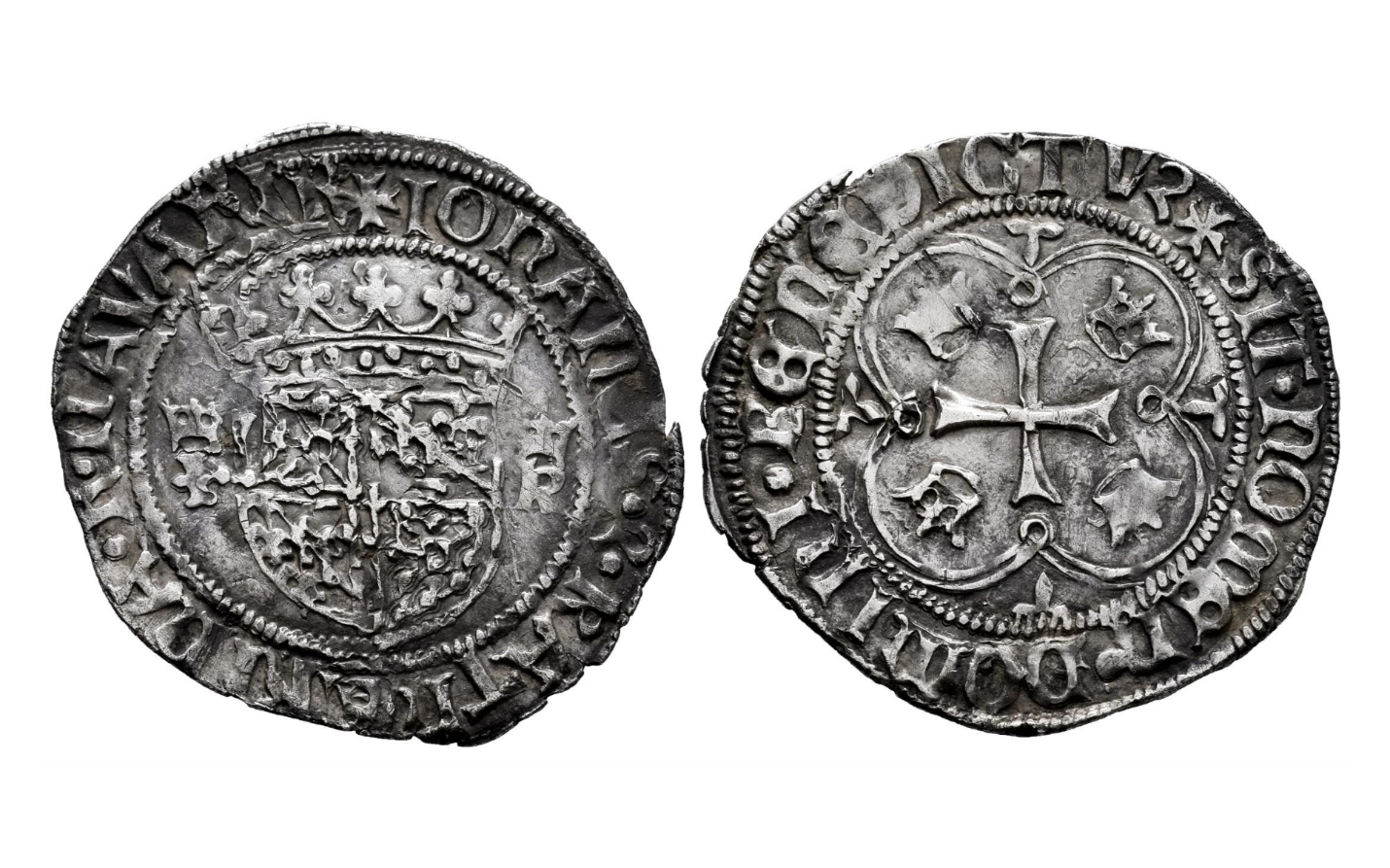 Silver real minted in the name of Catherine of Navarre (1483-1517) and John (1484-1516) – silver content of 11 deniers (917 mils) – 2.38gr – Principe de Viana Collection – €4200 auction price
Silver real minted in the name of Catherine of Navarre (1483-1517) and John (1484-1516) – silver content of 11 deniers (917 mils) – 2.38gr – Principe de Viana Collection – €4200 auction price
Obverse: IOHANES: Z: KATHERINA.R.NAVARR
Reverse: SIT:NOMEN:DOMINI:BENEDICTV Z
Tauler & Fau Auctions, Auction 144, Lot 1319 24.06.2024
Three other known silver real coins feature two crowns and two lilies on the reverse and do not have any crowned letters on the sides of the coat of arms:
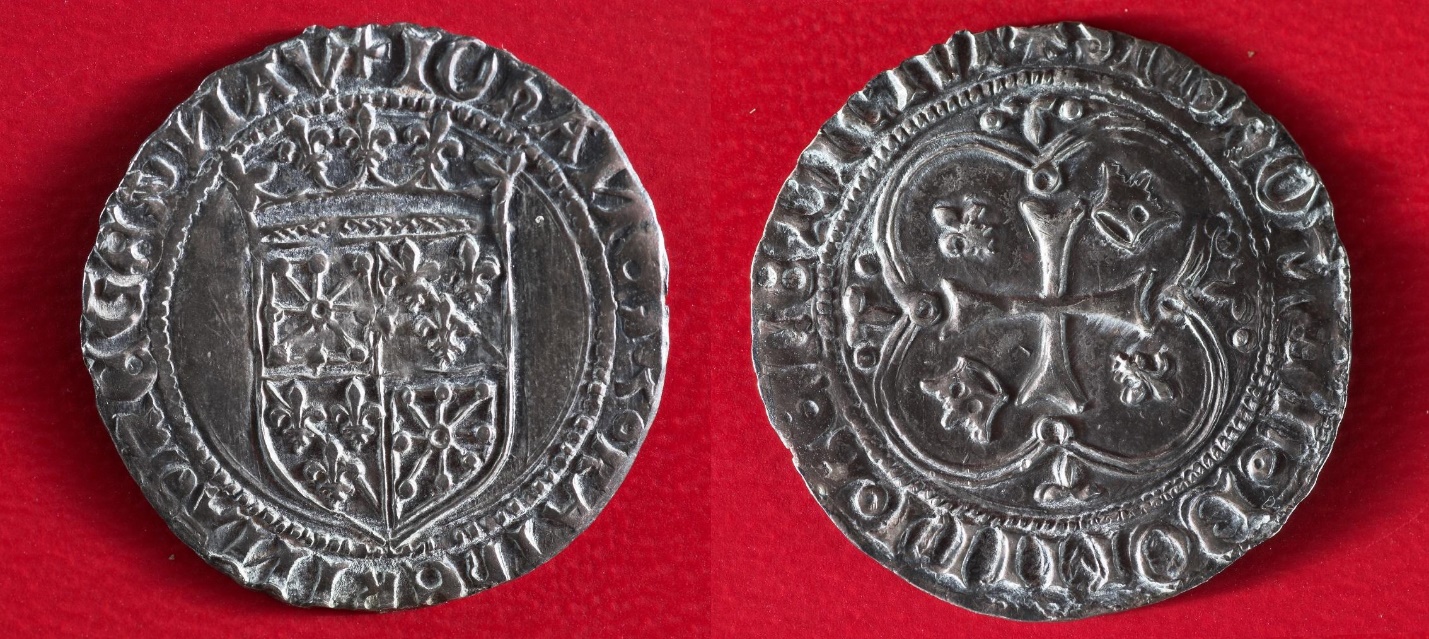
Silver real minted in the name of Catherine of Navarre (1483-1517) and John (1484-1516) – silver content of 11 deniers (917 mils) – 2.40gr – 26mm diameter
Obverse: IOHANES: Z: KATHERINA.REGES.NAV
Reverse: SIT:NOMEN:DOMINI:BENEDICTVM
Museum of Navarre MN N004856 Object

Silver real minted in the name of Kings Catherine of Navarre (1483-1517) and John (1484-1516) – silver content of 11 deniers (917 mils)
Obverse: IOHANES: Z: KATHERINA.REGES.NAV
Reverse: SIT:NOMEN:DOMINI:BENEDICTVM
Former Luis Gomez collection
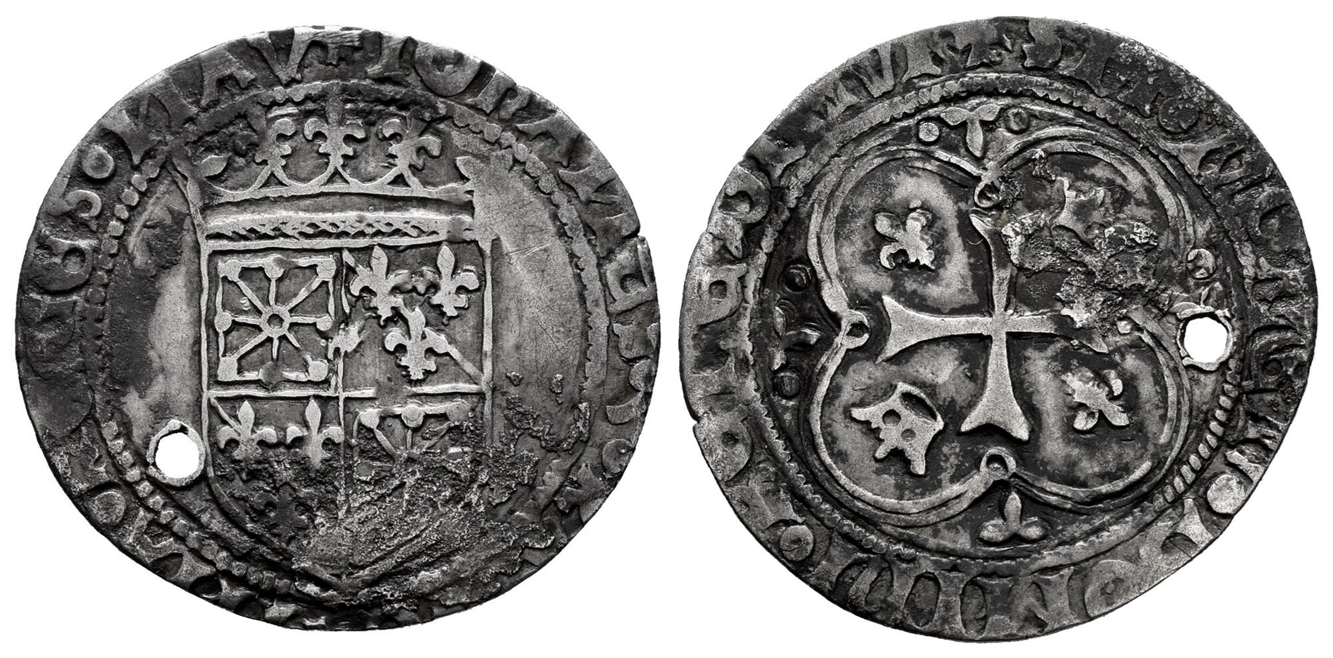
Silver real minted in the name of Kings Catherine of Navarre (1483-1517) and John (1484-1516) – silver content of 11 deniers (917 mils) – 2.06gr – €1500 auction price
Obverse: IOHANES: Z: KATHERINA.REGES.NAV
Reverse: SIT:NOMEN:DOMINI:BENEDICTVM
Tauler & Fau Auctions, Auction 93, Lot 2014 05.10.2021
Out of these last three coins, the first and third share dies and piles on both the obverse and reverse. The second, while having great similarities on the obverse, has a different reverse.
We have no details regarding the silver half reales mentioned in the Minting ordinance, as no known specimens have been found to date.
But let's get back to the gold coins. Although we are not aware of any known specimens of double reales, two pieces of half reales are known and both are in the treasury of the Instituto Valencia de Don Juan in Madrid. They were discovered by the expert Miguel Crusafont in 1982 and they present two completely different designs. I haven't been able to collect any photos of these coins for the moment and I will use here the drawings that the expert Miguel Ibañez shows in his book:
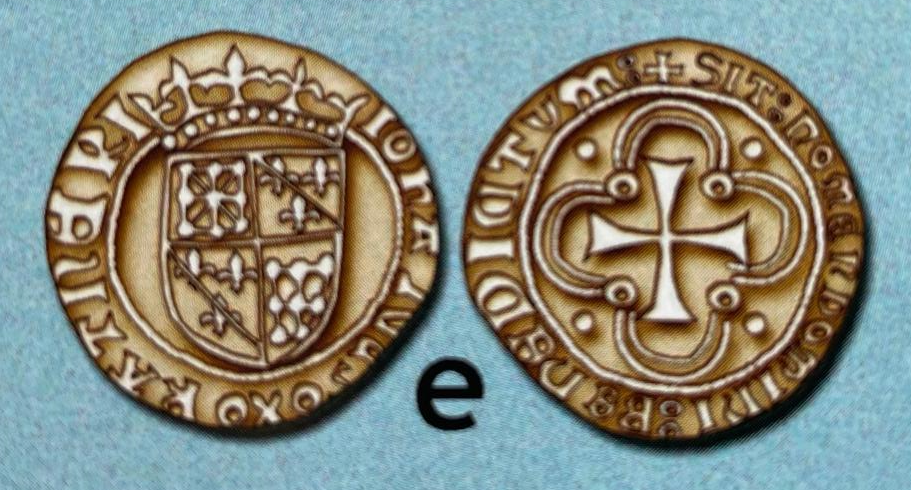
Gold half real minted in the name of the kings Catherine of Navarre (1483-1517) and Juan (1484-1516) – 22 carat content (917 mils) – 1.70gr – 18.5mm Diameter – Instituto Valencia de Don Juan
Obverse: IOHANES: Z: KATHERI…
Ifrentzua: SIT:NOM…:DOM..
Instituto Valencia de Don Juan
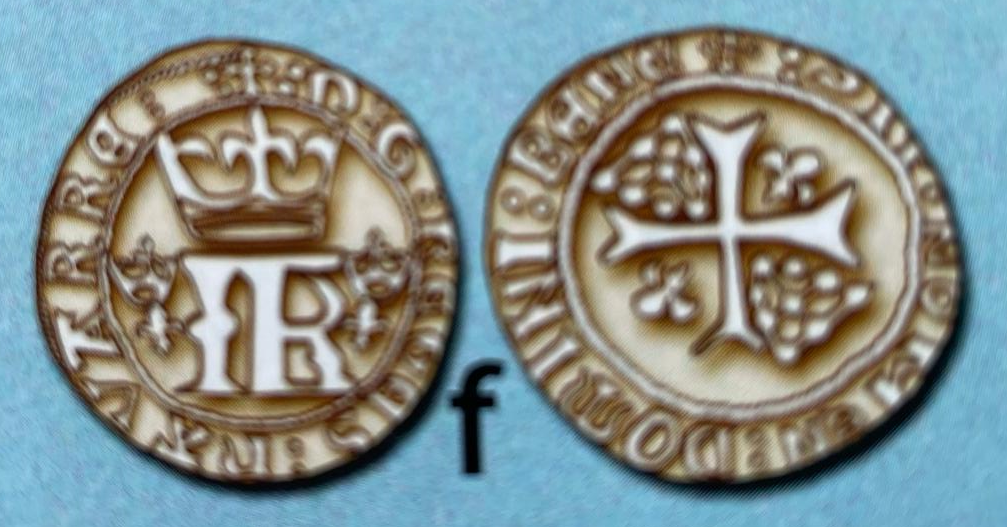
Gold half real minted in the name of the kings Catherine of Navarre (1483-1517) and Juan (1484-1516) – 22 carat content (917 mils) – 1.60gr – 18mm Diameter – Instituto Valencia de Don Juan
Obverse: D:G:REGES:NAVARRE
Ifrentzua: SIT:NOMEN:DOMINI:BENE
Instituto Valencia de Don Juan
The first half real model follows the design of the whole reals, showing the coat of arms of the Evreux family on the obverse and the lobed Templar cross on the reverse.
The second model reminds me on the reverse the coins minted by the Prince of Viana. This impression can be further strengthened if we look at the known quarter reales. The two different types of these gold quarter real coins are as follows:
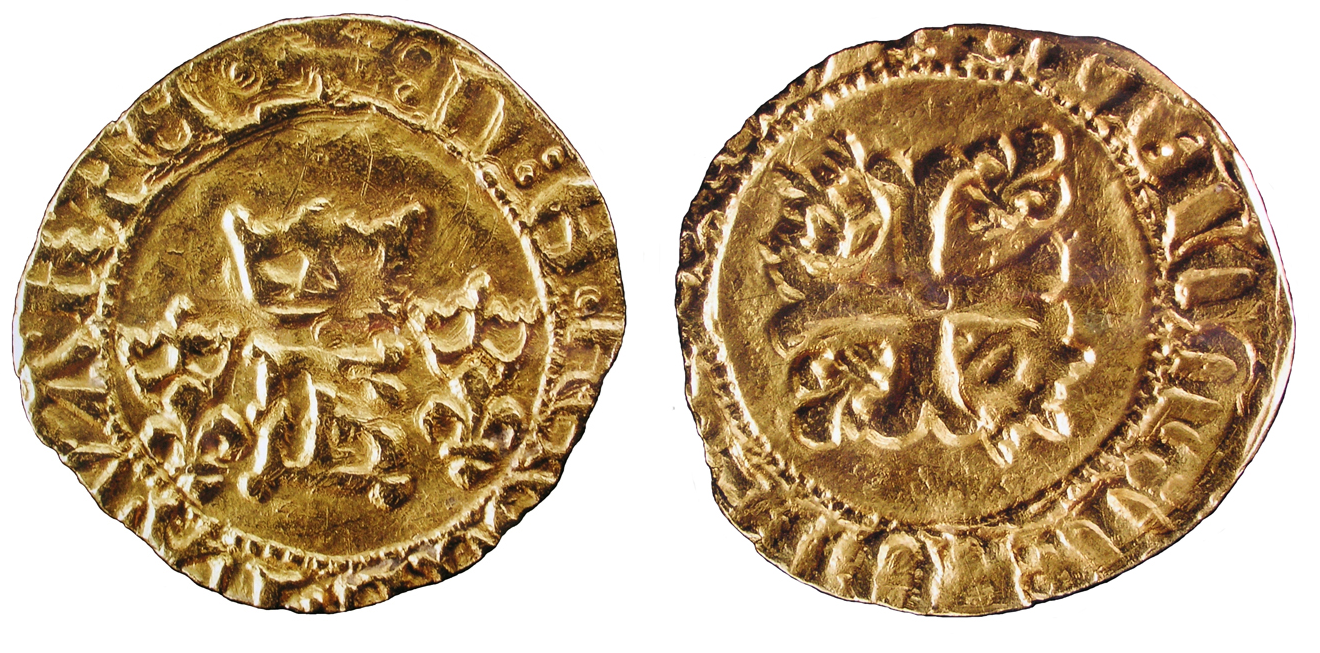 Gold quarter real minted in the name of Kings Catherine of Navarre (1483-1517) and John (1484-1516) – 22 carat content (917 mils) – 0.83gr – 14mm Diameter – Formerly a Ros family coin
Gold quarter real minted in the name of Kings Catherine of Navarre (1483-1517) and John (1484-1516) – 22 carat content (917 mils) – 0.83gr – 14mm Diameter – Formerly a Ros family coin
Obverse: D:G:REGES:NAVARRE
Reverse: SIT:NOMEN:DOM:BENEDICTV
Ros family photo
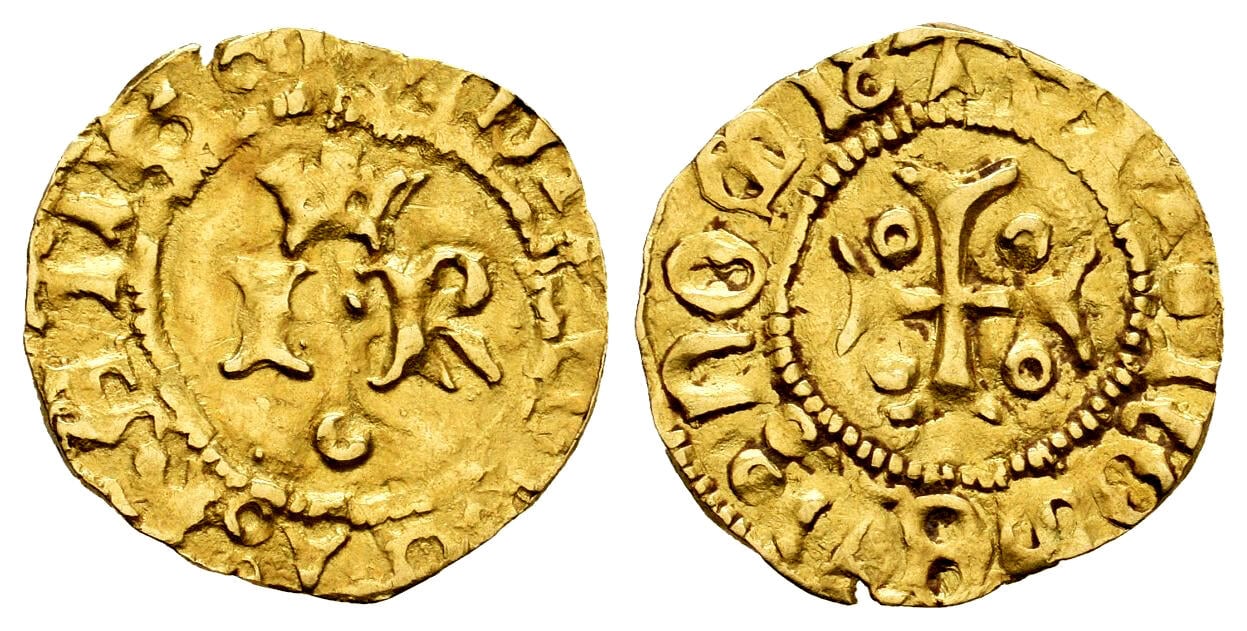
Gold quarter real minted in the name of the kings Catherine of Navarre (1483-1517) and John (1484-1516) – 22 carat content (917 mils) – 0.81gr – 14.2mm Diameter – Former Caballero de las Yndias (22/10/2009), 1664 specimen and Principe de Viana Collection – €7000 auction price
Obverse: IOHANES:ET:KATHE
Reverse: SIT:NOMEN:DOMI
Tauler & Fau Auctions, Auction 144, Lot 1318 24.06.2024
The first quarter real has striking similarities to the second half real previously seen. The second quarter real, on the other hand, resembles a cornado coin, a golden cornado!
We have already mentioned that we have no information about the double gold reales; the coinage law mentions them but perhaps they were not minted or no specimens have survived to our days, as it may have evenly happened with the silver half reales.
The last type of coin described by the coinage law were the sezenas or tarjas of billon. These tarjas or sezenas were minted in very large quantities, between 1506 and 1512 more than a million tarjas were minted. All these pieces were used for a long time after the conquest of the Kingdom of Navarre, since the new rulers did not mint any more tarjas and due to their long use, many of the pieces that have survived to our days are currently quite worn. Some of these pieces show a re-stamping of a small coat of arms of Navarre, ordered in 1524 during the reign of Emperor Charles.
Three main types of tarjas can be distinguished.
The first is the rarest and shows gothic scripting on the I and K letters which can be found in the middle of the obverse:

A billon tarja or sesena struck in the name of the kings Catherine of Navarre (1483-1517) and John (1484-1516) – silver content of 3 deniers and 16 grains (305 mils) – 2.04gr – Principe de Viana Collection – €800 auction price – Gothic Scripting of IK
Obverse: IOHANES:Z:KATHERINA:REGES:NA
Reverse: + SIT : NOMEN : DOMINI : BENEDICTWM
Tauler & Fau Auctions, Auction 144, Lot 1320 24.06.2024
The second type follows the same model of the first one but presents Latin scripting for letters I and K; on the reverse, there is no decoration around the arms of the cross. Two subgroups of this type can be distinguished by looking at the appearance of the obverse, depending on whether or not they feature the letter P, which may be the initial of the mint city (Pamplone):
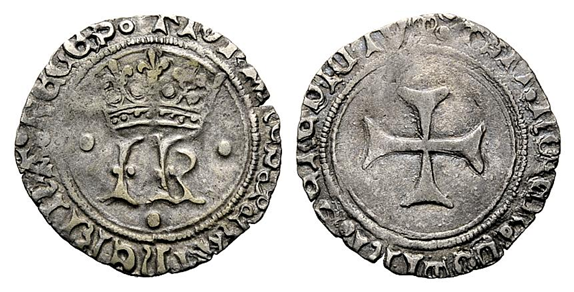
A billon tarja or sesena struck in the name of Catherine of Navarre (1483-1517) and John (1484-1516) – silver content of 3 deniers and 16 grains (305 mils) – Latin IK letters, besants around the I and K letters, without P letter
Obverse: IOHANES:Z:KATHERINA:REGES
Reverse: + SIT : NOMEN : DOMINI : BENEDICTV
Cayón Subastas, Auction May 2012, Lot 415 16.05.2012
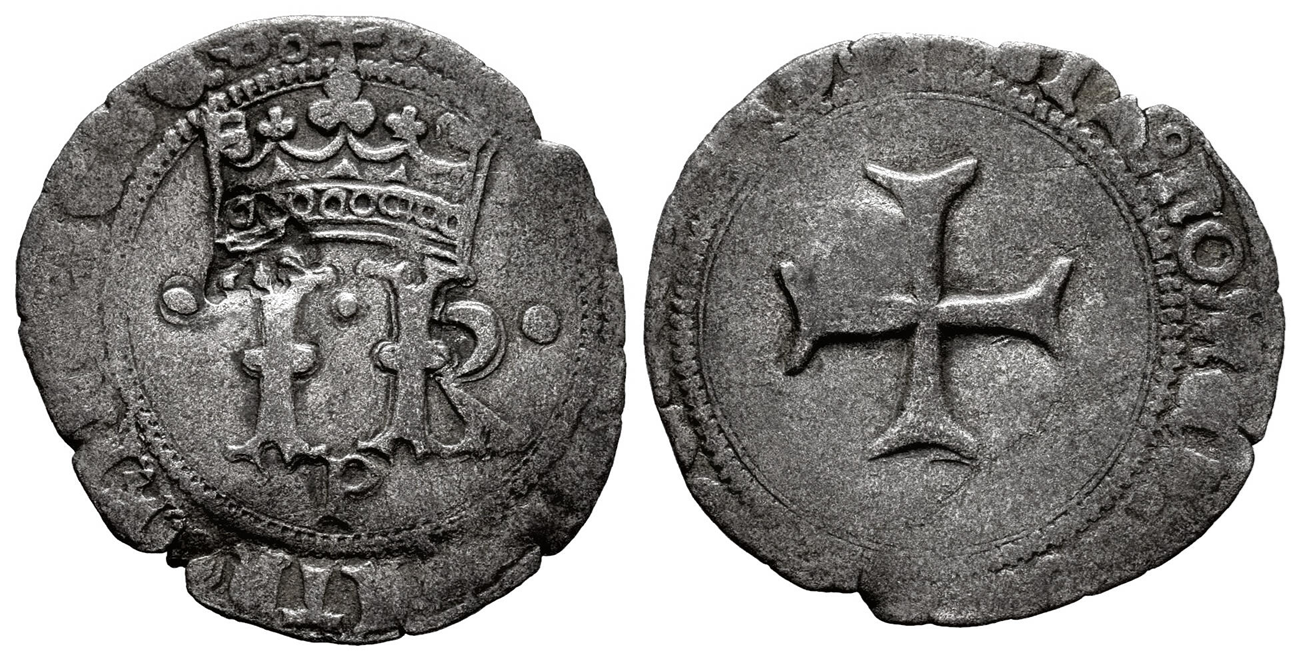
Billon tarja or sesena struck in the name of the kings Catherine of Navarre (1483-1517) and John (1484-1516) – silver content of 3 deniers and 16 grains (305 mils) – 1.92gr – Latin IK letters, besants beside the letters I and K, but letter P at the bottom – Re-stamping of year 1524 – Principe de Viana Collection – €320 auction price
Obverse: IOHANES:Z:KATHERINA:REGES
Reverse: + SIT : NOMEN : …
Tauler & Fau Auctions, Auction 144, Lot 1323 24.06.2024
The last third group is similar to the second subgroup of this second group but presents embellishments around the arms of the cross on the reverse. These embellishments consist of two crowns and the letters I and K. Depending on the relative positions of the embellishments, different subgroups can be formed.

A billon tarja or sesena struck in the name of the kings Catherine of Navarre (1483-1517) and John (1484-1516) – silver content of 3 deniers and 16 grains (305 mils) – 2.25gr – Latin IK letters, besants beside the I and K letters, P letter at the bottom, embellishment in the I-Crown-K-Crown direction – Principe de Viana Collection – €1600 auction price
Obverse: IOHANES:ET:K:ATHERINA:RE
Reverse: + SIT : NOMEN : DOMINI : BENEDICTV
Tauler & Fau Auctions, Auction 144, Lot 1328 24.06.2024
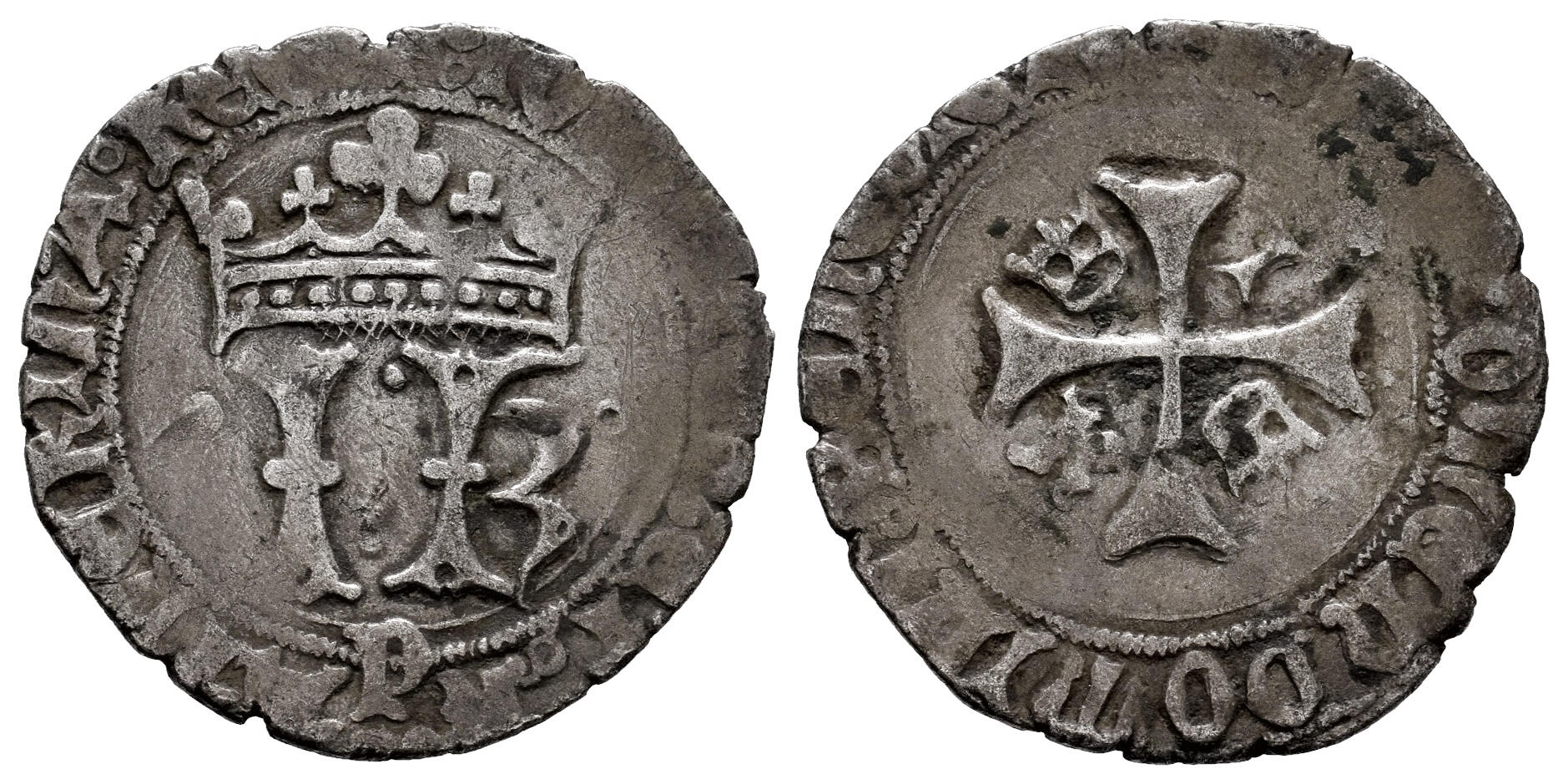
A billon tarja or sesena struck in the name of the kings Catherine of Navarre (1483-1517) and John (1484-1516) – silver content of 3 deniers and 16 grains (305 mils) – 1.93gr – Latin IK letters, besants beside the I and K letters, P letter at the bottom, embellishments in the Crown-I-Crown-K direction – Principe de Viana Collection – €170 auction price
Obverse: IOHANES:ET:K:ATHERINA:REG
Reverse: + SIT: NAME : DOMINI : BENEDICT
Tauler & Fau Auctions, Auction 144, Lot 1327 24.06.2024
The cornado and the half-cornado or negretes were not mentioned in the coinage law of the second period, but they were in the form of a possible draft preserved in Document 28 of Box 164. In the blog entry dedicated to the first coinage period we already examined the cornados and negretes of this reign and we will therefore refer readers to that entry.
We have analyzed the minting ordinance of the second coinage period of the reign of Catherine and John at the beginning of the entry. The coinage accounts written from the beginning of the new ordinance until July 1506 have not survived to our days. Therefore, we do not have information on the coin types and quantities minted from January 1494 till July 1506.
But starting at that date, Document 51 of Box 167, kept in the General Archives of Navarre, and written by the guard named Johan Miguel Garceys contains the accounts that clarify those details to us. But before that, on July 14th 1503, according to what is shown in Document 30 of Box 167, it is said that there was a certain Johan de Aguyreguy a new "contrarrole" (counterguard); but the coinage accounts he wrote or analyzed (if he did write them at all) have not reached us.
The coinage accounts written by Garceys or Garces are preserved in a 125-page book. Until now, they had not been studied and as a result we did not know how many and what types of coins were struck by the mintmaster Beleguer d'Aoyz. This is how Garces begins:
„En el nombre de dios y de la gloriosa birgen maria y del glorioso senor san Miguel arcangel y de todos los santos y santas de la corte celestial comienzo yo Johan Miguel Garceyz goarda de la moneda este prste libro pa tener recibo todas las monedas de oro e de plata q en la moneda se batera desde ogi martes a VIII de Julio 1506 que tome la prosesion del dcho my oficio de guarda en Adelante, plegue a ntro senor me de gracia pa de acabar en su santo servicio”.
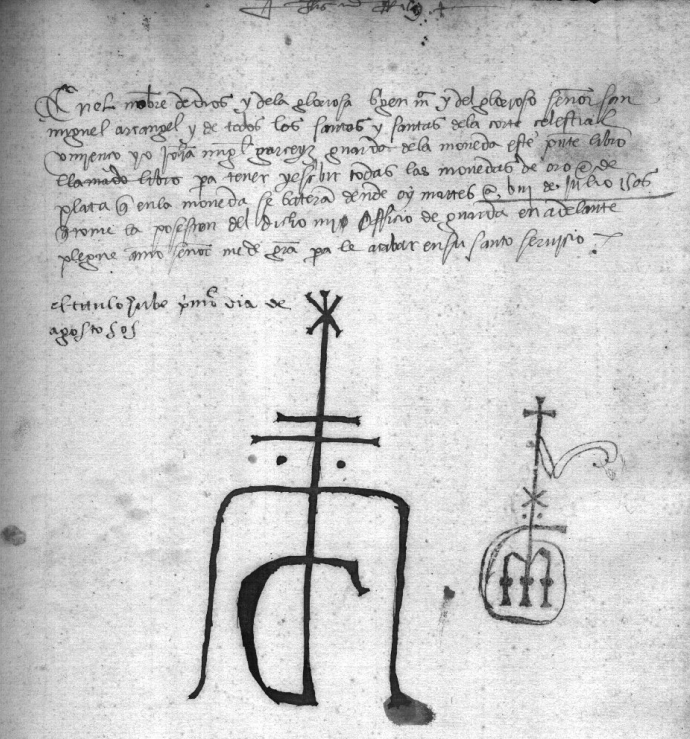
First page of the coinage accounting book of guard Johan Miguel Garceys
Courtesy of the Royal Archives of Navarre AGN, Box 167, First page of document 51.
The coinage accounts of this Garceys are not comparable to those of the former guard Pedro Marcilla. Pedro provided the general weights of the gold coins minted, along with the fineness given in the assay, the number of coins minted out of each mark, and the seigniorage payment. Miguel Garceys only provides the gold coin marks, ounces, and pieces minted in each entry, without the fineness result in the assay, the coin number minted per mark or the seigniorage payment. Let us look at the first entry of a page dedicated to the mintage of gold coins:
“Esto es el oro batido en la casa dela moneda en el año Myl Quynyentos e ocho empezando en Abril.
R2 Primo a V del dicho se labro en la moneda hun marco dos onzas VI piezas de Reales de oro
🡪 IM II Oz VI”
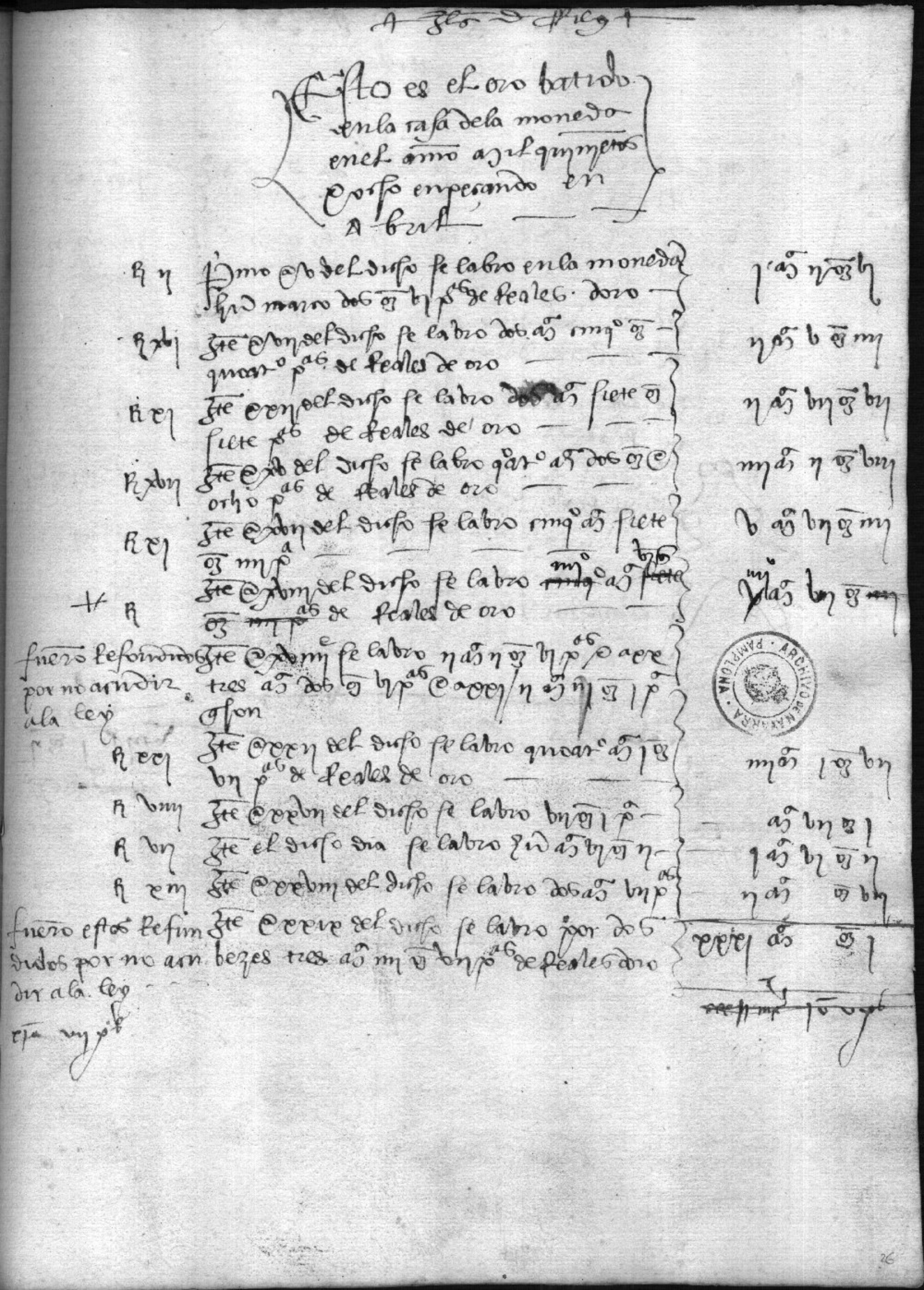
Courtesy of the General Archive of Navarre AGN, Box 167, Document 51, Page 24
Nominally, each rough mark provided 72 pieces and each ounce provided 9 reales, so the total number of gold coins minted in this entry was 96 reales. In Pedro Marcilla's earlier accounts of gold minting, the exact number of coins minted out of each mark was mentioned. Most often it was 72 pieces, but sometimes it went as high as 72.25 or as low as 71,875. In these entries by Garceys, I have always taken 72 pieces as the per mark value minted, since the number of coins minted out of each gold mark is not mentioned.
As for the R2 that appears before the accounting entry, I am not entirely sure of its meaning but it seems to be an abbreviation for “Rompieronse 2”. Two entries on the same page read “fueron refundidos por no acudir a ley” and the number of coins in these accounting entries is not included in the general sum of the month. At the end of each month, on the right side of the page, the sum of all minted coinage entries is shown in marks, ounces and remaining pieces. These month-end sum ups have been very useful in verifying the readings of the number of coins minted.
The general monthly additions only appear from 1508 onwards; before that date, we have no other backup to verify the accounting entries.
In some other entries, starting at the end of 1509, when a few pieces were taken as test specimens, Garceys began to report them. The reading “Tome Chantillo” or “tome santillo” appears in the coinage accounts, on the left side of the corresponding entries. The word Chantillo or santillo comes from the French word “chantillon” or sample. Here is one of the entries that shows these words:

Courtesy of the General Archive of Navarre AGN, Box 167, Document 51, sub-entry on page 56
As mentioned above, document 51 of box 167 has a total of 125 pages. After analyzing all these pages, a summary of the gold coins having been minted is shown in the following table.
|
|
1506 |
1507 |
1508 |
1509 |
1510 |
1511 |
1512 |
Total |
|
Amount of Gold Reales |
3891 |
5548 |
9388 |
17103 |
23311 |
30955 |
15849 |
106045 |
|
Rough Marks (Ounces) |
432.33 |
616.44 |
1043.11 |
1900.33 |
2590.11 |
3439.44 |
1761.00 |
11782.78 |
|
Pure Gold (Ounces) |
396.31 |
565.07 |
956.19 |
1723.97 |
2374.27 |
3152.82 |
1614.25 |
10782.88 |
|
Seigniorage Tax Revenue |
?? |
?? |
?? |
?? |
?? |
?? |
?? |
?? |
|
Value (gros) |
53.33 |
53.33 |
53.33 |
53.33 |
53.33 |
53.33 |
53.33 |
53.33 |
Summary of gold reales minted between 1506 and 1512
During these six years, around 106,000 reales were minted and for the minting of all these coins 330 kilograms of pure gold were used. We do not know the amount of seigniorage tax revenue that this coinage generated to the royal household, but since we know that the tarja or gros value of one gold real remained stable (AGN, 168 box n° 15, II), it should have been around 7.855 livres 3 sous and 8 deniers.
The last gold real minted in the name of Kings Catherine and John was minted on August 20th, 1512 . The capital of the kingdom, Pamplona, surrendered to the Castilian army on July 25th, but the coins under the name of the royal couple were minted for almost another month after the capitulation. On this last day, August 20th, 40 gold reales were minted; these were the last coins minted in the name of the legitimate kings in Pamplona.
Thanks to the analysis of the coinage accounts of the reigns of Francis Phoebus and Catherine, we can show the development of gold coinage during this period. Unfortunately the lack of accounts between 1494 and 1506 prevents us from drawing any definitive conclusions, but as the following graph shows, the trend in the amount of gold coins minted was upward. In addition, it would be quite reasonable to suspect that the new coinage law of 1495 would have initially encouraged the minting of large amounts of gold coins. It should be noted that the decrease in the amount in 1512 is related to the breaking out of the war and the conquest, just as the increase in the amount in previous years could have been related to the tension experienced with the kingdoms of France and Castile. Let us look at this aforementioned graph of development.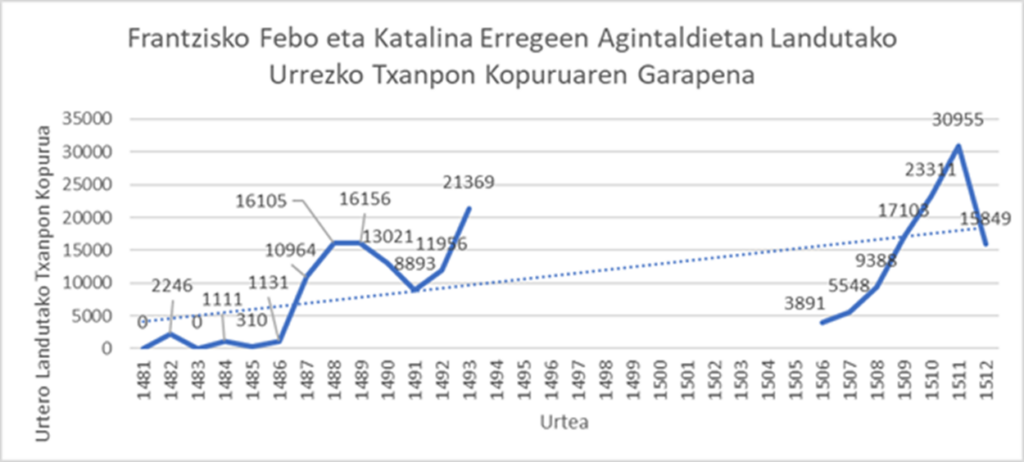
If we complete the graph of the number of minted gold coins per year with a photo of the type of gold coin minted in each of those years, the following would be the result:

The number of gold coins minted each year along with a display of their appearance
Let's now look into the accounts of the mintage of tarjas or sezenas that were worked out during those years. The first tarja accounts that show general monthly sums ups also begin in year 1508:
„Estas son las tarjas batidas en la casa de la moneda del año myl quinientos e ocho empezando en Marzo
Primo a XIIII del dicho mes de marzo se labro por los obreros de billo de tarjas beynte e cinquo Marcos –🡪 XXV M
…..“
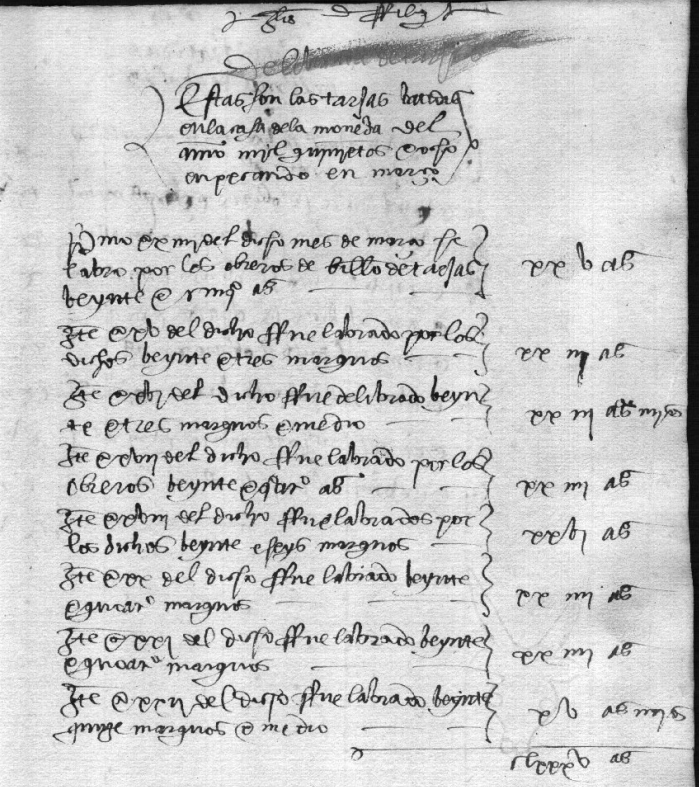
Courtesy of the General Archive of Navarre AGN, Box 167, Document 51, sub-entry in page 36
There is no regular data on the number of tarjas minted per rough mark in these accounts. In a few of the entries, only a few in the year 1509, it is stated that 104 or 104 ¼ or 104 ½ tarjas were minted per mark. Since nothing is stated in all the rest of entries, I have assumed the nominal number of tarjas in my calculations, that is, 100 tarjas minted per rough mark. It is likely that real number was above these 100 tarjas per mark, but I have decided to take the lower baseline for the calculations.

Courtesy of the General Archive of Navarre AGN, Box 167, Document 51, sub-entry in page 57 – “a 104” number of tarjas struck out of each mark
The tarja accounts do not report any broken or sampled specimens. The first year's accounts report the number of rough marks provided to employees and the number of tarja marks that resulted out of them:
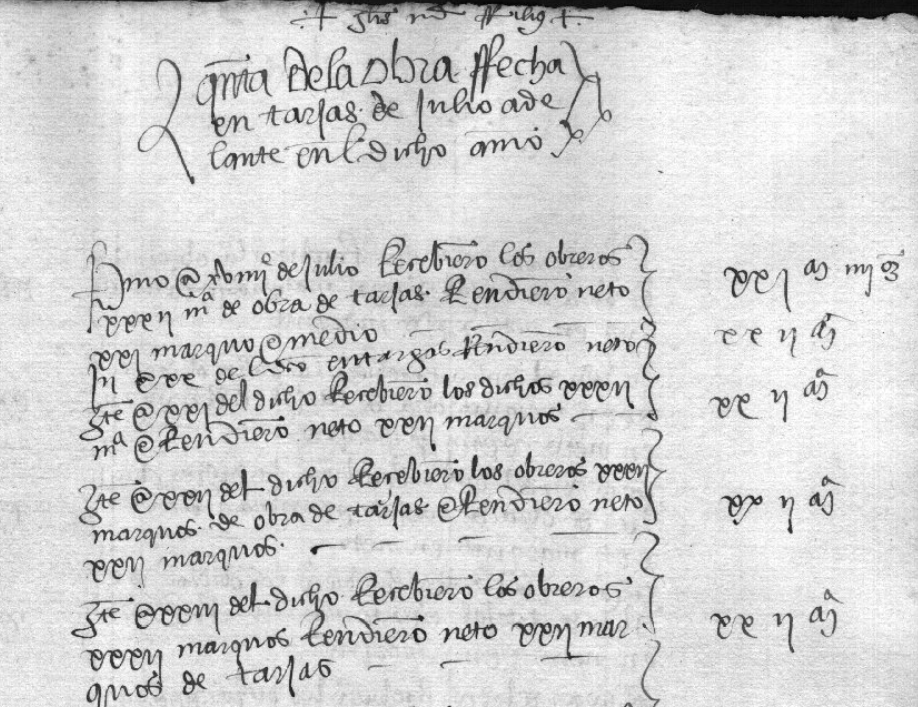
Courtesy of the General Archive of Navarre AGN, Box 167, Document 51, Sub-entry in page 7
„Quenta de la obra fecha en tarjas de julio adelante en el dcho anno (1506)
Primo a XVIIII de Julio recibieron los obreros XXXII marcos de obra de tarjas. Rendieron neto XXI Marquos e medio -🡪 XXI M IIII Oz
Item a XX del dcho en tarjas rendieron neto -🡪 XXII M
Item a XXI de dcho Recibieron los dchos XXXII marcos e rendieron neto XXII marquos -🡪 XXII M“
Ikus daitekeenez, egunero 32 bat lanketa marko ematen zitzaizkien langileei haien tarja txanpon lanketarako, baina hauetatik 10 edo %30 inguru, lanketa prozesuan zehar galtzen zen (geroago ere birziklatzen zen arren).
The number of tarjas which were produced over these six years was very large, with a total of more than 1.1 million being produced, and for the production of all these tarjas around 815 kilos of pure silver were used. At this time we cannot estimate the seigniorage tax collected. Document 28 of Box 164 of the Navarrese Archives, a draft of the coinage ordinance possibly dated between 1492 and 1495, established that the seigniorage tax collected from each fine silver mark had to be 15 sous. At the time of the coinage of Francis Phoebus or first period under Catherine, the tax was at 30 sous. Is it possible that the tax was halved after the coinage law of 1495? It seems unlikely, but who knows…
Here is a summary of the number of tarjas or sezenas minted between 1506 and 1512. As mentioned, the minting accounts provide us the number of marks which were minted; from these I have extrapolated the number of tarjas, in most cases using the nominal number which ought to be minted out of each mark. In a few cases, during year 1509, the exact number of minted coins per mark which was indicated by the accounts has been used.
|
|
1506 |
1507 |
1508 |
1509 |
1510 |
1511 |
1512 |
Total |
|
Number of billon Tarjas |
65350 |
94050 |
144650 |
258141 |
176500 |
164350 |
200900 |
1103941 |
|
Rough Marks |
653.50 |
940.50 |
1446.50 |
2574.00 |
1765.00 |
1643.50 |
2009.00 |
11032.00 |
|
Silver Marks |
197.41 |
284.11 |
436.96 |
777.56 |
533.18 |
496.47 |
606.89 |
3332.58 |
|
Seigniorage Tax Revenue |
?? |
?? |
?? |
?? |
?? |
?? |
?? |
?? |
|
Value (gros) |
1.33 |
1.33 |
1.33 |
1.33 |
1.33 |
1.33 |
1.33 |
1.33 |
Summary of the billon tarjas produced between 1506 and 1512
Once again, if we look the evolution of the number of coins valued at 16 cornados since 1481 in a graph, we can see a clear upward trend. Francis Febus minted very few groses and Catherine did not mint tarjas until 1495. However, we only have data on the number of minted tarjas from 1506 onwards.
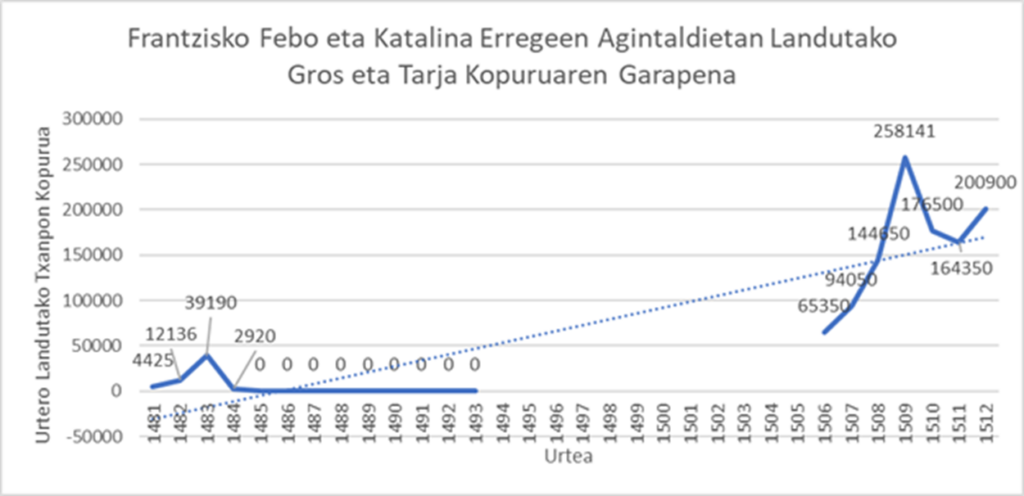
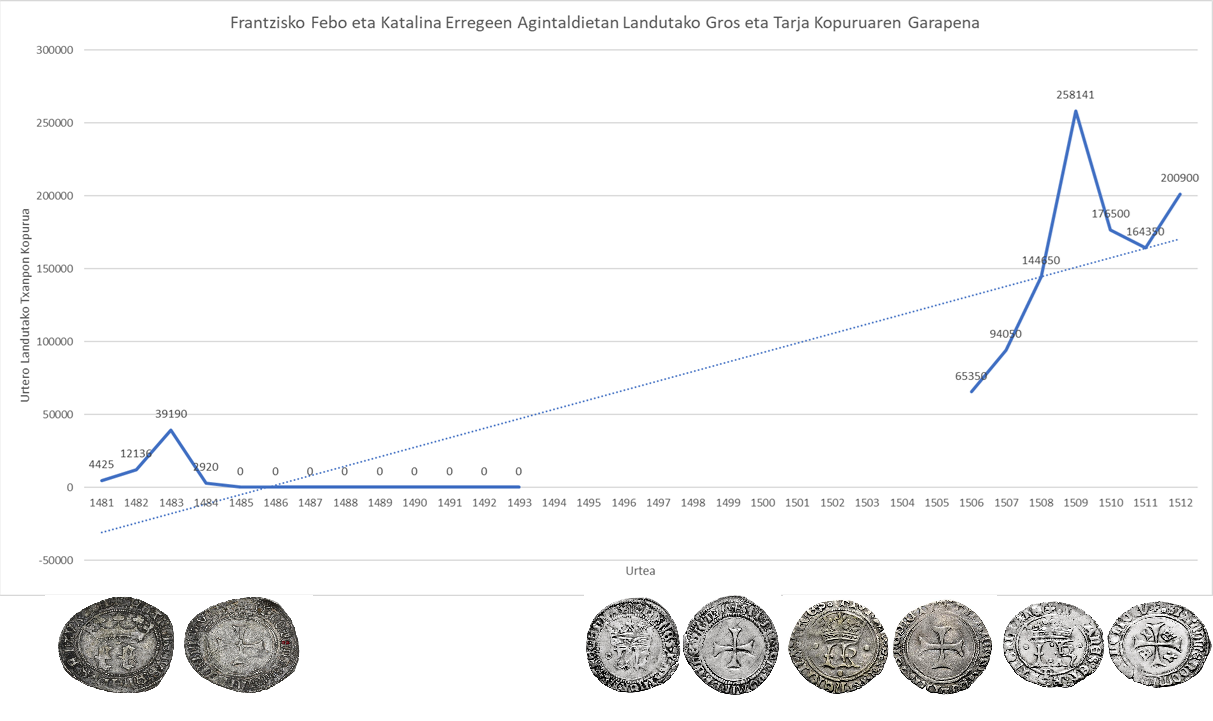
The number of gros and tarja coins minted in each year, along with their appearance. In the case of tarjas, the time axis and the evolution between the different tarja models are only used as an illustrative example; note that this data is so far unknown and should be taken with caution.
And what kind of evolution did the production of cornado coins have? Let's look at a cornado coinage accounting page:
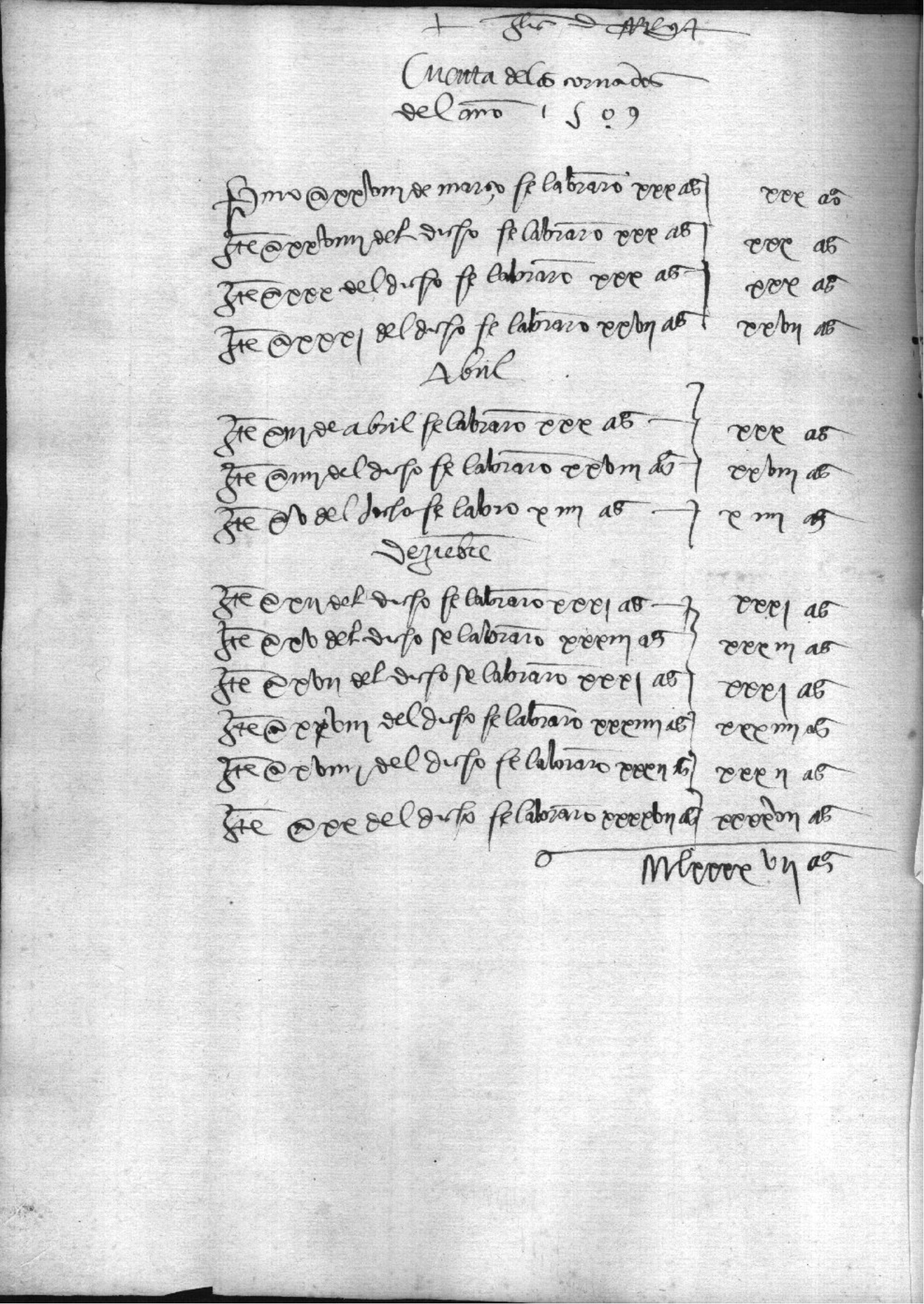
Courtesy of the General Archive of Navarre AGN, Box 167, Document 51, sub-entry in page 67
"Cuenta de los cornados del año 1509
Primo a XXVIII de Marzo se labraron XXX M
Item a XXVIII del dcho se labraron XXX M"
In the cornado account entries there is no data in terms of assay, seigniorage or on the number of coins which were minted per mark. In my calculations, instead of taking the nominal number of minted cornados per mark, i.e. 256 coins, I have taken 16 additional cornados, up to 272 coins per mark. The allowed remedy was as high as 280 or 288 pieces per mark, but in previous mintages the mean quantity had usually been 272. This has therefore been the value which has been used for the calculations, and once again, this average value must be taken as a baseline.
There is a single page, where the remedies that resulted during the delivery of Cornados' at the end of year 1506 are described:
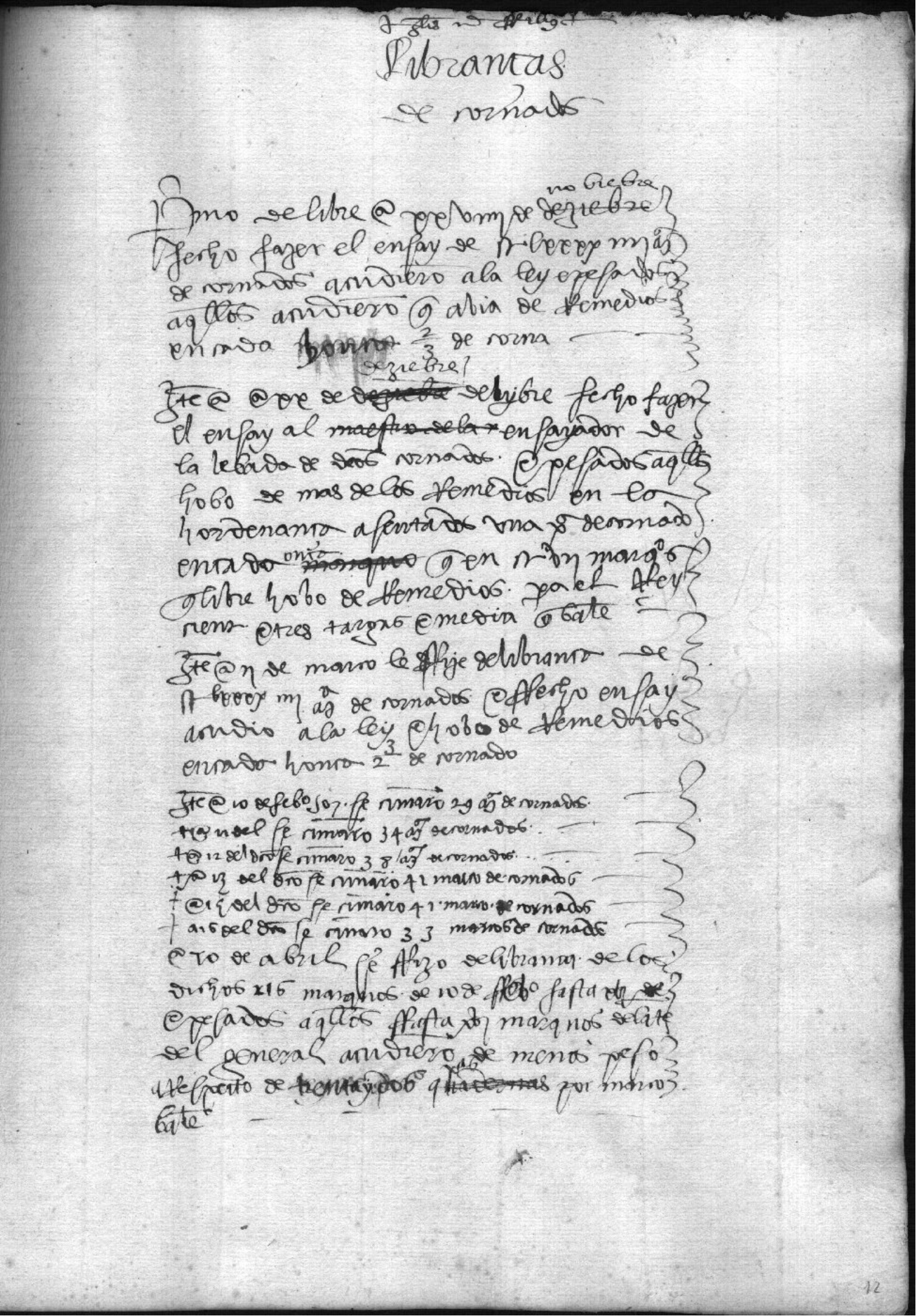
Courtesy of the General Archive of Navarre AGN, Box 167, Document 51, sub-entry in page 14
"Libranzas de Cornados"
primo delibre a XXVIIII de Novembre fecho fazer el ensay de 290 marcos de cornados anduvieron a la ley e pesados aquellos anduvieron q abia de remedios en cada honza 2/3 de cornado
Item a XX de dezembre delibre fecho fazer el ensay al ensayador de la lebada de dchos cornados e pesados aquellos hobo de mas de los remedios en la hordenanza asentados una pieza de cornado en cada onza que en CCVII marquos que libre hobo de remedios pa el rey ciens e tres tarjas e media que bate.
Item a II de Marzo le dije delibranza de CLXXXXIIII marcos de cornados e fecho ensay anduvieron a la ley e hobo de remedios en cada onza 2/3 de cornado.
…..
A 10 de Abril se fizo delibranza de los dichos CCV marquos de ….del general anduvieron de menos peso al respecto de treintaydos piezas por marquo batidos.”
According to the above, the remedies ranged between 8 and 32 pieces per rough mark and, consequently, we can accept the average value of the 16 pieces used as a first approximation.
Here are the details of the production of cornado pieces as described by Garceys the guard. No cornado coins were produced in 1507 and, in general, the quantities produced were quite modest, with a decreasing trend. In the production of all these cornados about 21 kilos of pure silver were used, a much smaller number than the one used in the production of the tarjas.
|
|
1506 |
1507 |
1508 |
1509 |
1510 |
1511 |
1512 |
Total |
|
Number of Billon Cornados |
278800 |
0 |
115056 |
107984 |
70856 |
53992 |
43928 |
670616 |
|
Rough Marks |
1025.00 |
0.00 |
423.00 |
397.00 |
260.50 |
198.50 |
161.50 |
2465.50 |
|
Silver Marks |
35.59 |
0.00 |
14.69 |
13.78 |
9.05 |
6.89 |
5.61 |
85.61 |
|
Seigniorage Tax Revenue |
?? |
?? |
?? |
?? |
?? |
?? |
?? |
?? |
|
Value (in deniers) |
2 |
2 |
2 |
2 |
2 |
2 |
2 |
2 |
Summary of the billon cornados struck between 1506 and 1512
This downward trend will be more evident if we compare it with the numbers which were struck between 1481 and 1494:
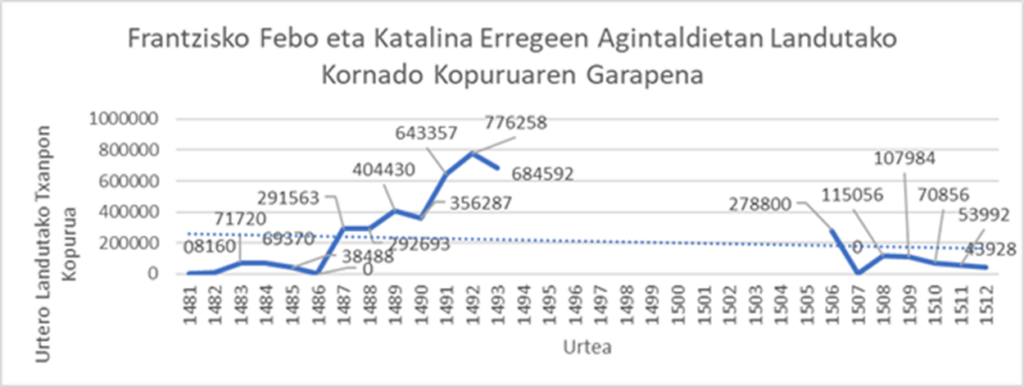
And let's finish today's entry by looking at the coinage entries of half-cornados or negretes.
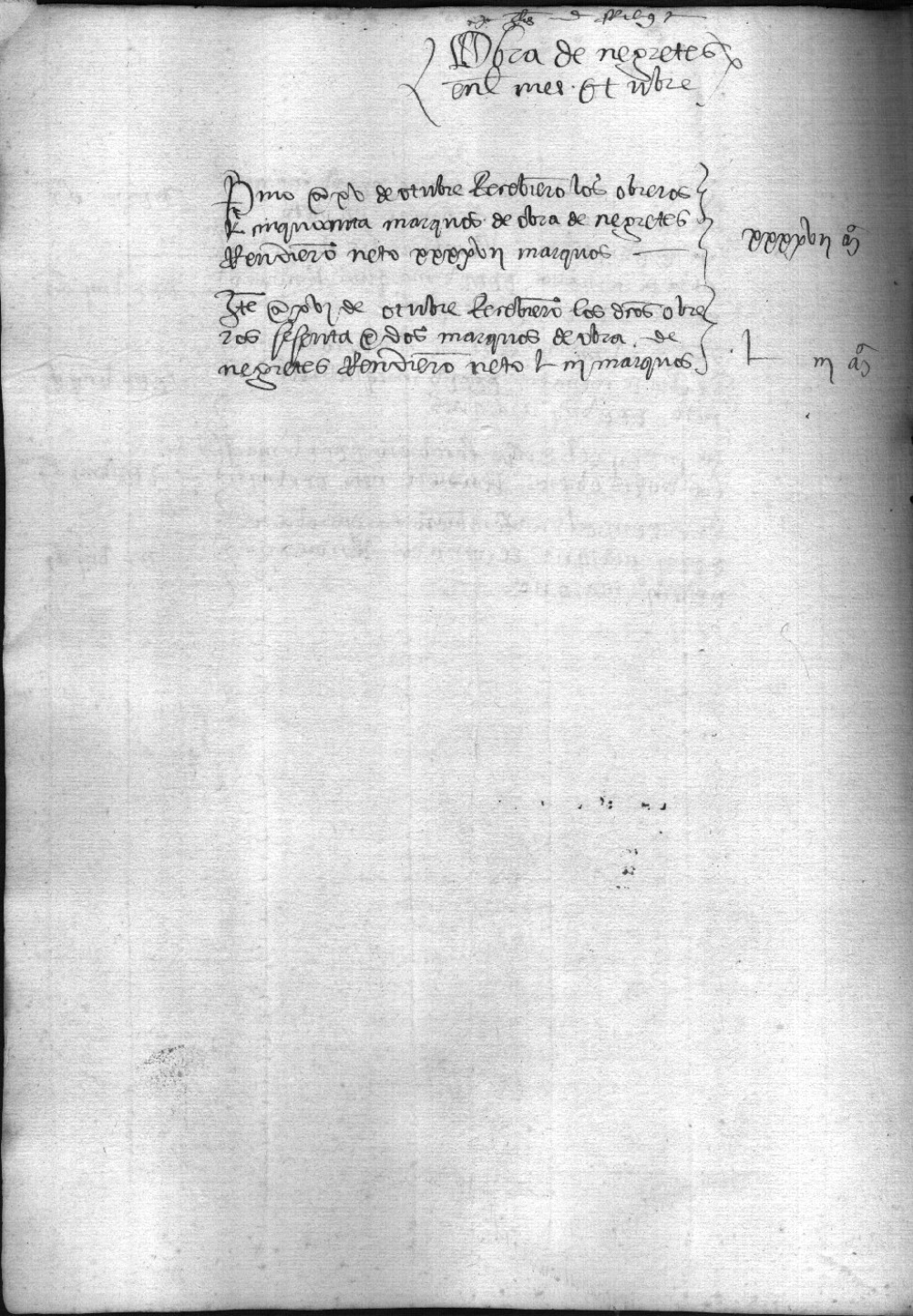
Courtesy of the General Archive of Navarre AGN, Box 167, Document 51, sub-entry in page 13
“Obra de negretes en el mes de Otubre
Primo a XV de Otubre recibieron los obreros cinquonta marquos de obra de negretes rendieron neto XXXXVII marquos -🡪 XXXXVII M
Item a XVI de Otubre recibieron los dchos obreros sesenta e dos marquos de obra de negretes rendieron neto LIII marquos -🡪 LIII M”
In these Negrete account entries we also do not have any data in terms of assay, seigniorage tax revenue or on the number of coins minted out of each rough mark. In my calculations, instead of using the nominal outcome of negretes per mark, that is, 352 coins, I have increased 16 additonal coins to thar number, 368 negrete coins minted per mark. The allowed remedy was up to 384 negretes, but in most previous mintages the mean number of struck negretes was around 368. This has therefore been the taken value, which must also be taken as a baselina.
Tarja eta kornadoen kasuan eman bezala, 1506. urteko lanketa kontuek langileei entregatutako lanketa markoen eta sortutatako negrete markoen arteko gonbaraketa datuak eskeintzen dizkigute. Kasu batzuetan galerak txikiak izan ziren, besteetan berriz haundiagoak, %15 eta %20 artekoak. Hurrengo urteetan, 1507. urtetik aurrera, horrelako datuak desagertu egin ziren lanketa kontuetatik.
Here are the quantities of negretes that were struck and which were described by Garceys the guard. No negretes were struck in the years 1507 and 1511 and in general, the quantities were not big, similar to the quantities of previous years. During the coinage of all these negretes about 2.30 kilos of pure silver were used, considerably less than the number used in the production of cornados.
|
|
1506 |
1507 |
1508 |
1509 |
1510 |
1511 |
1512 |
Total |
|
Number of negretes |
35696 |
0 |
48944 |
9568 |
72496 |
0 |
31648 |
198352 |
|
Rough Marks |
97.00 |
0.00 |
133.00 |
26.00 |
197.00 |
0.00 |
86.00 |
539.00 |
|
Silver Marks |
1.68 |
0.00 |
2.31 |
0.45 |
3.42 |
0.00 |
1.49 |
9.36 |
|
Seigniorage Tax Revenue |
?? |
?? |
?? |
?? |
?? |
?? |
?? |
?? |
|
Value (in deniers) |
1 |
1 |
1 |
1 |
1 |
1 |
1 |
1 |
Summary of the half-cornado or negrete quantities produced between 1506 and 1512
The trend which is quite stable is more evident if we compare it with the numbers struck between 1481 and 1494:
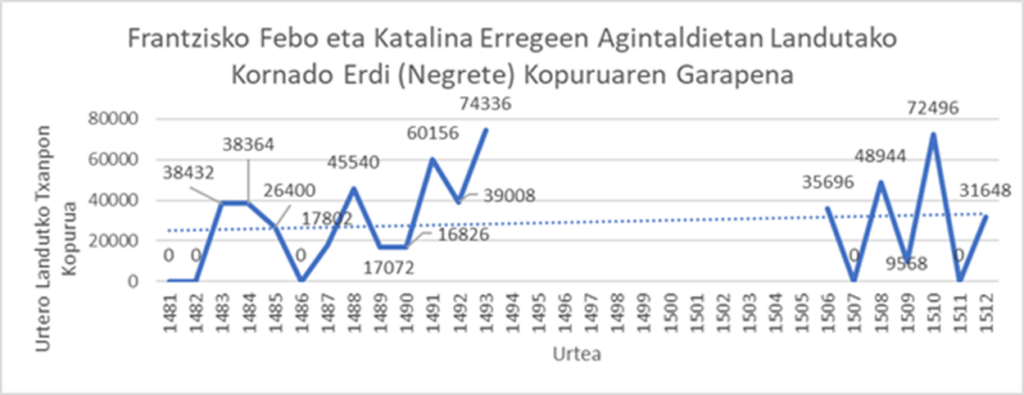
If we superimpose all of the graphs shown so far, we will get an overall view of the relative number of different coins minted during these periods.
If at the beginning of the reign of Catherine and John, the production of cornados took absolute priority, it is clear that by the end of the reign this priority had moved to the tarjas or sezenas. The production of negretes or half cornados was relatively limited and had a stable trend. In general, the production of gold coins remained relatively stable but showed a constant upward trend; the economic health of the kingdom improved throughout the reign and the 330 kilos of gold produced in the last six years are not a negligible amount.
It is truly a pity that the accounts of the coinage between 1494 and 1506 have not reached our days; it would be absolutely enlightening to get to know the numbers of gold reales, tarjas and especially silver reales minted during those years. Who knows, maybe they will reappear someday!!
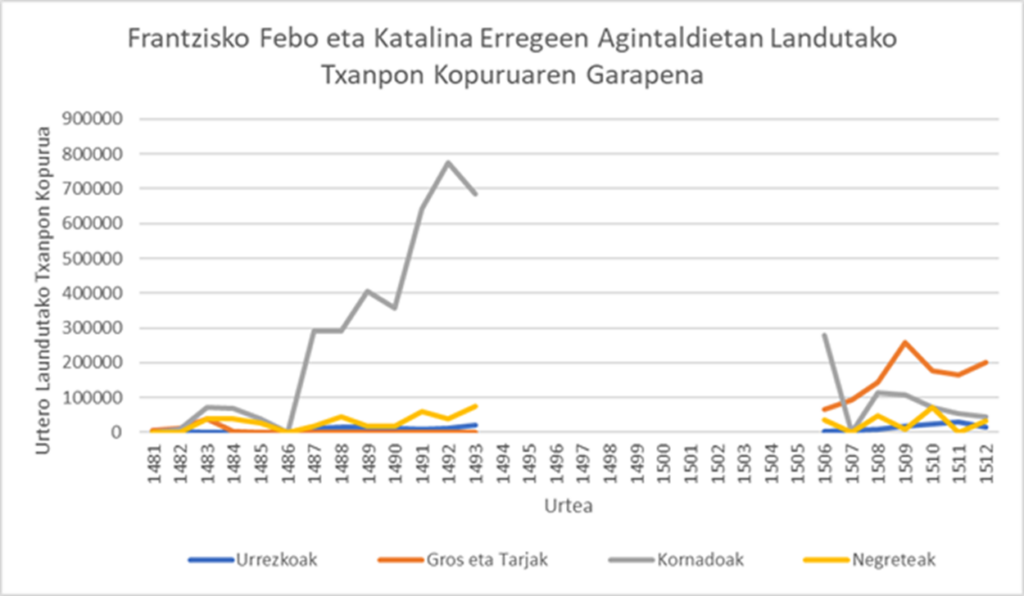
During the preparation of this study I have used several interesting documents; I have not been able to include a large part of their content in the previous analysis. However, much of this content is of great interest to numismatist researchers and as a result I will transcribe them after the bibliography.
Likewise, within the bibliography, I will upload the excel spreadsheet containing the accounts of Document 51, Box 167, of the General Archives of Navarre, in the hope that it may also be helpful in the future.
Bibliography:
Senoreaje Y Produccion Monetaria en el Reino De Navarra a Fines del Siglo XV – Juan Carrasco – 2003 – link
Moneda medieval navarra –Manual de Numismatica – Miguel Ibañez Artica – 2021
Monedas navarras inéditas de Francisco Febus (1479-1483) y de Catalina y Juan de Labrit (1483-1512) – Miquel Crussafont i Sabater – Acta Númismatica N°12 -1982 – link
Monedas de Francisco Febo, efímero rey de Navarra (1479-1483) – Miguel Ibañez Artica – 2017 – link
LA MONEDA EN NAVARRA – MUSEO DE NAVARRA – EXPOSICION DEL 31 DE MAYO AL 25 DE NOV 2001. Miguel Ibáñez Artica – link
CATÁLOGO GENERAL DE LA MONEDA DE NAVARRA – Ricardo Ros Arrogante – 2013 – Altaffaylla argitaretxea
La numismática medieval navarra: antecedentes y situación actual – 2000 – Miguel Ibáñez Artica – link
Retablos tardogóticos de la catedral de Pamplona – 2024 – Clara Fernández-Ladreda Aguadé – link
Excel Sheet of Coinage Accounts Contained in AGN167N51 – Monakotik – link
Notas aclaratorias sobre algunas monedas de oro, acuñadas en el reino de Navarra -Joaquin Lizarraga – Gaceta Numismática, 120, 1996, pp. 11-20
Itinerario de los reyes privativos de Navarra: Juan III de Albret-Catalina I de Foix (1483-1517) – ÁLVARO ADOT LERGA – – link
———————————————————————————————————————-
Here is a possible transcription of Document 28, Box 164, of the Archives of Navarre. I will start on page six, since the previous pages deal with agreements of the estates and details regarding the coinage of Bearn. From that page onwards, the document appears to contain a draft of the coinage laws and minting ordinances. The mint master indicates the costs and expenses incurred in the minting of gold reales, silver reales, and billon tarjas and cornados. The handwriting is quite difficult to understand and has many scratches and comments, reinforcing the idea that it is a draft. We have no way of knowing whether these drafts were later legalized.
6. Recto
Don Johan et Dona Catherina. A los amados ntros Martin de Aoyz, mayor de edad maestro (y en su ausencia a Berenguer de Ayoz, menor de edad), Martin Cruzat general, Pedro de Caparroso guarda e Miguel de Espinal Ensayador de nuestra moneda real e a cargo de vostro. Salut fazemos vos saber q nos con acuerdo e consentimiento de las personas paello dispuestas por los tres estados deste nuestro reyno e deliberacion delas gentes de nuestro consejo real e de personas assi mercaderes como otras personas y ententidos q saben en arte de moneda por lo que anter fruyro simple e bien de la cosa publica destee dcho ntro reyno atendido e considerado q anos incumbe e pertenece echar moneda, entendido que ahora buenamente so se falla moneda en el, e por la mucha variedad e diversidad de monedas de fuera q corren en el e no haver ygualdat de curso ny ley con las tales monedas q son de los Reynos tierras e fronteras comarcanas confinantes. Se alimenta a este ntro Reyno sesigne mucha confusion y gran danyo e menoscabo en los bienes e faziendas de los mercadantes q les es necessaryo conciartar fuera del reyno y portan el pueblo queda dello decebido y en muchas cosas perdido. Queriendo rellenar a ntros subditos q tanto gran danyo atanye al buen bienusal suyo de toda fanga e dayno q benga les podreja e darles lbra probechosa buena e favorable pa tratar sus comercios e mercaderias con moneda comun e util para rodobeobrda pronta sobrello con las gtes de ntro regno hifron e deliberado e ordenado demandar fazer y bater (Many portions are scratched) —>
Faran a ley de tres dineros beynteun granos argent fin haura remedio en la ley bun grano e no mas de manera q sean a IIII dineros argent lo Rey sin otro Remedio enla dcha ley, seran de talla en la xxx a ocho sueldos IIII dineros. los quales se faran assi Reales doro comom los Reales de plata e medios e quartos assi los xxx sezenes todos a peso segun dicho esta de suso ordenada de manera q no aya feblaja sino todos iguales segunt dcho peso pieza por pieza pesado segunt de suso es dicho
——————————————————-
6. Verso
Moneda de oro e de plata e de billon en este dcho Reyno por la cantidad e probecho y dello se seguira e assin que en el Reyno se falle moneda de aquel. La qual dcha moneda sea fecha e batida de la ley talla forma e orden contenyda en las ordenanzas just aprobadas.
Primeramente se faran Reales medios Reales e quartos de Reales doro a la ley de XXII quilates seran LXXII en marquo pesara cada pieza de oro a II dineros XIIII granos por lo qual balera la pieza de oro delos dchos Reales doro cada una quarenta tarjas o sezenes de la moneda blanca q de bajo contiene entpues mandamiento e fazer seabien medios reales al dcho respecto e quarto de Reales tan bien algunos por q aya de todas piezas e bien assi dobles reales de pro, a doble peso de oro y ala ley mesma de los dchos Reales de oro y baleran al respecto el doble de los dchos Reales doro.
No les menos se faran/bateran Reales e medios Reales de plata a la ley de XI dineros II granos de peso de II dineros argent fin, abran remedio en la ley a II granos, de peso de dos dineros, dela buna parte haura buna cruz con quatro coronas y de la otra las sobre dcha armas, balera cada Real tres sezenas e al respecto Reales de medio como dcho es.
no sea osado de cercenar ni falsificar de la dcha moneda so pena de la vida e de ser su persona e bienes a ntra merced e silo fiziere q encorra enla dcha pena. Et por sy dello alguno ny algudo no ayan ny puedan allegar ny pretender ignorancia mandamos e queremos las sean publicada e pregonada en esta ntra ciudad de Pan y en las otras ciudades e billas del Reyno donde cumplira por los lugares usados e acostumbrados mediante carta prente. Dado en ntra ciudad de Pamp con el sello de ntra chanc a XXI dias del mes de mayo Ano MCCCCLXXXXV.
De la qual dcha moneda doro batera a marquo doro q sea en berga o otra manera q llegase a XXII quilaes e un quarto por marquo sesenta Relaes de oro de buen peso e de buena ley como esta dcho,e assi mesmo batera marquo e plata de Pamplona y de Paris o otra plata fina rendida a beynte ciqn florines de moneda q son XXXVII libras X sueldos e no mas e las otras monedas de oro y de plata q al presente corren en este ntro Reyno baldran como agora balen en enomas. Sy alguno sea osado de dar mas por las dchas monedas ny por marquo de oro ny de plata so pena de ntra mercer e de Cien libras a satisfacer a ntros cofres reales
—————————————————–
7 Recto
E por Semejante se batera e faran sezenes e medios sezenes de ley de III dineros e XXI granos argent fin con un grano de Remedio en la ley de manera que sean a IIII dineros argent lo rey seran de talla a VIII sueldos IIII dineros de peso ….. e haura de la una parte una cruz y de la otra una J e una K con una corona, balera cada sezen seze cornados.
E balera plata marcada de Pamp y de Paris bien o otra plata fina XXV florines de moneda de la suso dicha moneda por marco q son XXXVII libras X sueldos y nomas y nenguna sera osado de dar mas de las dchas XXXVII libras X sueldos de plata q sea delibrada so pena C libras a pagaderes a ntros cofres reales e las otras monedas de oro y de plata balera su curso acostumbrado segun q a presente corre en este ntro Reyno e no mas.
E por evytar todo danyo malizia y menoscabo e por aqlo que se podra seguyr en el bater e fazer de la dch ntra moneda queremos e nos plaze e manda du nos q nenguna moneda se haya de fundir ny fazer lebranza de la q se batera y fara de oy en adelante sino q se faga por todos bosotros juntamente fallan dchos presentes y no en otra norma.
En la qual dcha manera e orden sudo dcha queremos sea batida e fecha la dcha moneda. Por tanto declarando ntra boluntat deliberacion e acuerdo a bos dchos maestros e a los otros oficiales de la moneda suso nombrados dezimos emandamos q bistas las presentes ruego fagues bater e fazes las sobre dchas monedas de oro de plata y de bellon de la ley talla e pesos susos dichos y con la solicitut e diligenza q en ello conviene sin faltar mudar ny perbertir cosa alguna en la factura ley e peso de la dchas monedas y en las otras cosas acerca dello ordenadas acordadas y asentadas por la dha ordenanza las dchas monedas queremos ayan curso e anden en todo este Reyno como monedas reales. Mandamos por las mesmas presentes a todos los officiales e subditos med so aquellas penas q encorre aquellos q refusan la moneda de sus sres q tomen en Renta las dchas monedas de oro e plata q por bosotros lanbandas e fechas bater e fazidas por ordenacion e mandamyento ntro en la forma e valor suso dcha cal aquellas den curso e conmparten con las asimismo otras monedas de su sr. Car esta es ntra deliberada boluntat elo q rumpte a ntro nsigno e sufino deste dcho ntro Reyno. Dado en ntra ciudat de Pamp so el sello de ntra chanc. a XXI dia del mes de Mayo Ano MCCCCLXXXXV.
——————————————————–
7 verso
Asi mesmo y por ebitar todo danyo e malicia menoscabo e peligro q se podra seguir ent bater dela dcha moneda es acordado e deliberado q daquy en adelan en nengun tiempo aya de fundir ny librar moneda alguna sino en la casa de la moneda llamada la torre del rey y asi se faran por todos juntas todas las delibranzas y el fundir por el maestro, bos el general, guarda y ea bos myguel del Espynal ensayador por las presentes mandamos q de todas las monedas de oro de plata e billon q se faran q antes que sean derramadas faga el ensay de la moneda e dando vtro Report al guarda ntro el qual tendra en conansisueto las muestras de todas dchas deliberanzas con vtra signat e puedan dar assi es ntra boluntat y en ausencia de bos el dcho Myguel de Espynal mandamos por presente a vos Myguel Cruzat general fagays las dchas deliberanzas y su ensay e dares al dcho mtro guarda los Reports delas dichas deliberanzas asin que no se de bacante la dcha casa de la moneda ny les sea detenydo a los que daran su oro plata e billon a la dcha moneda.
Don Johan et dona Catherina a todos quienes las presentes beran e oyran salut fazemos saber que nos considerando q a los Reyes deste dcho ntro Reyno es dado y pertenece echar moneda empues de su coronamiento por lo qual e porla gran necessitar q ay al presente de ofrere de moneta en todo el dcho Reyno porque se han seguydo grandes danyos por dar lugar a monedas estrangeras en mas alto precio de su balor, Myrando en el Reparto dello e por lo que a ntro Reyno Compte rebren benefficio e utilidad de la Repub. con acuerdo e deliberacion de las personas paello designadas por los tres estados e de las gentes de ntro consejo real e de otros q saben y entienden en arte de monedar ayamos deliberado ordenar e mandado bater e fazer moneda de oro de plata e de billon es asaber Reales doro q dela una parte hauran la senyal dela cruz e de la otra parte ntras armas reales q se bateran a la ley de beynte dos quarats bun quarto hauran remedio un quart de quyrat en la dcha ley de manera q sean a XXII quyrats sin otro remedio e seran de talla en el peso a setentados piezas en el marquo q son nuebe piezas doro en la onza, se fara cada bun real de oro a dos dineros catorze granos e no haura remedio nenguno en la talla salbo q todo sea de peso e se faran medios e quartos reales e dobles reales al respecto y ley suso dcha. E assi bien se faran Reales de plata que hauran de la buna parte la cruz con quatro coronas e de la otra parte ntras armas reales como en la moneda de oro e se bateran a ley de onze dineros e dos granos argent fin haurean remedio en la dcha ley dos granos de manera q sean lo q mas baxo fuere a XI dineros argent fin sin otro remedio nenguno en la dcha ley seran de talla en el peso a VIII sueldos por marquo y biene a XII piezas en la onza, se fara cada pieza dos dineros e se faran si quisieren medios reales al respecto e a la ley sobre dcha. Y por semejante se faran sezenes q cada uno balga XVI cornados y hauran en la buna parte la cruz y en la otra buna Y y una K la corona de suso e.
Portanto mandamos atodos e qualesquiere ntros officiales e subdictos en el dcho ntro Reyno confirmydos q tomen e reciban den e delibren la dcha ntra moneda e tracten sus mercaderyas dadas y presas con aquellas assicomo con las otras monedas del Reyno sota las penas q encorren los que rehusan la moneda de su senor. Et nynguno ny alguno….
—————————————————–
8 recto
Abis de lo que nos queste pa fazer Reales qe balgan a IIII grosses contando la plata marcada de Pomp o Paris a XXVI florines de moneda por marquo que menos a ntro parecer no se puede fallar.
Primeramente si queriasmose nos las moneda de plata se puede fazer reales q balga a IIII groses e son a la ley de XI dineros y tres granos argent fin en que abra remedio en la ley III granos de manera q lo mas baxo fuese en la ley sean a XI dineros e ninguno el remedio de los dichos dos granos, prarafiese aquello segun pa la senorya e sera de talla en el marquo aL peso brenso por marquo de oliva e haura remedio en cada marquo un real praraefiese e sera aquel remedio assi bien pagada la Senyora de la qual moneda es segunt se signe
Primeramente del un marquo de la plata marcada de Pamp e de Paris dara XXVI florines de moneda q asi sale ——————————————————————————————> XXXVIIII Libras
Item data a la senorya por su senoriaje por marquo de plata XII sueldos —————> XII sueldos
Item se dara a los obreros por sus trabajos de cortar e pesar y olzar por cada marquo dos sezenes por lo sume las mesmas ———————-> V Sueldos IIII dineros
Item se dara a los monederos por monedar por cada marquo bun sezen —————-> II sueldos VIII dineros
Item haura el maestro por fonder cosinnar emblanquir y pa las deliberanzas en sueldos e todos sus trabajos por marquo de plata XVI Suelos —————————————————> XVI sueldos
Suma toda la obra fecha de bun marquo —————————————–> XXXX Libras XVI sueldos
Pedro de Marzilla de Caparroso Martin Cruzat Martin de Aoyz
Abis de los q nos parese sezenes quando la plata marcada de Pomp y Paris a XXVI florines de moneda por marquo q por menos a ntro pareser no se puede fallar.
Primeramente nos pareste se puede hazer sezenes q cada una balga seze cornados y puede haver de ley a tres dineros e XVI granos argent fin abiendo remedio en la dcha obra ley bun grano e mas q sea a tres dineros e quinse granos sin otro remedio en la dicha ley e serbira entalla ent el peso a ocho sueldos e quatro piezas en el marquo de obra y en quanto a la dicha talla q es el peso q aya de remedio buna pieza q es bun sezen por marquo de la dcha moneda. Los quales dchos remedios paraefriere nos pareste de ser fer de la Senorya
La qual sobredcha moneda establecida ordenada y batida por mandado de sus altezas e de los designados de los estados en la sobre dicha ley y entre peso por quanto la plata al tipo de la dicha ordenanza balia a beynte e ocho florines ya lo que menos se puede fallar amenos de beynte e seys el marquo. Nos pareste debe faser en el peso a cien y quatro piezas por marco de obra q se ayan de a quatro piezas por marco a causa de la sobre dicha pnya de L flor de la dicha plata
Y los gastos de estas ordenanzas q se Recogen pa fazer la sobre dicha moneda en cada marquo de plata son las siguentes signadas presentes por marquo de plata marcada de Paris o Pamp, se dara a XXVI florines por q no se puede allar por menos ——————————————> XXXVIIII Libras
Se dara a la Senyora por su Senoreaje por marquo de plata la suma de XV sueldos——–> XV sueldos
Se dara a los obreros por cortar y pesar piezas, por piezas obrar por su brazaje q han de fazer tres marquos de sezenes por marquo de plata; seis groses ————————————-> XII sueldos
Por las mesmas de los dichos tres marquos a los dichos obreros q se faga en Vrostar en Recoger Redomar e obrar; tres groses ——————————————————————–> VI Sueldos
—————————————–
8 verso
Item a los monederos por cunyar las monedas los dchos tres marquos de obra tres grosses ——————————————————————————————————————> VI Sueldos
Item se dara al maestro por el cuyre que en cada marquo de plata ha menester XVI onzas tenga que ne vales ———————————————————————————————-> VII sueldos
Item se dara al maestro por sus trabajos como es fonder mermas de suelos cortar ent armar emblanquecer e carbon por las dchas fondicions etarbo por los obreros e pa fazer las demzancas por la obra de los tres marquos ————————————————————> I Libra X sueldos
Suma de la expensa que en cada marquo de plata se requiere ————-> XXXXII Libras XVI sueldos
Abis de los cornados segun la balor de la plata que es a XXXVIIII libras marquo de plata marcada de Pamplona o Paris
Primo en bun marquo de plata de ley de XI dineros e nuebe granos ay CCLXXIII granos argent fin de los quales habra en cada marquo de obra de cornados a XI granos de ley que monta los granos sobre dichos en obra pa ligar XXIIII marquos e III quartos
Item de los sobre dchos XXIIII marquos e III quartos en onzas se sacan de mermas y a la fundicion del maestro IIII onzas assibien palas mermas de los obreros en diez marquos buna onza o pa la las mermas del emblarquir con las mermas de los dchos obreros e IIII quartos onzas fundifibas
Las mermas de los dchos obreros ——————————————————————– > X Onzas
Asi ha de fazer el dcho maestro dela sobre dcha obra de cornados en net XXIII marquos y IIII Onzas y fara por onza VIIII quadernas al peso peso que los dchos XXIII marquos y medio montan ——-> LVI Libras VIII Sueldos
Los cargos de la sobre dcha obra de cornados son los que se sigue los quales no se pueden escusar
primo por el marquo de plata marcada de Pomp o Paris ———————————–> XXXVIII libras
Item XVI libras de cuyre pa la liga dela dcha plata que a II Sezenes montan ———–> IIII Libras VI sueldos
Item a la senoria por su senyoriage por marquo de plata XV Sueldos ——————-> XV sueldos
Item a los obreros que han de cortar a piezas por su brazaje a dos groses por marquo que los XXXIII marquos y medio monta —————————————————————> III Libras XIIII sueldos
Item a los monederos por monedar los dchos cornados a bun gros por marquo de hobra q monta ————————————————————————————————-> II libras VII sueldos
Pal Maestro por sus trabajos como son aliar fundir e por el carbon consielos e carbon de los obreros tal e a bun pal blanqueo por todos los trabajos en lod dchos XXIII marquos e medio de obra alira —————————————————————————————> V libras VI sueldos
Suma toda la obra fecha ————————————————————–> LVI libras VIII sueldos
La qual sobre dicha obra de cornados sera a ley de onze granos por marquo de obra con bun grano de Remedio en la dcha ley e sera de talla a treinta seis cornados por onza e assi hubiese feblaje sota este peso sera el dicho feblaje pa la senorya assi bien en los remedios de la ley si los hubiere
Assi bien sepide fazer negretes los quales se faran a la ley de seys granos abra remedio a bun grano por marquo en la dcha ley e sera de talla al peso a doze quadernas por onza q seran quarenta ocho negretes por onza e si fablaje hubiese nenguna sera pa la senorya assi bien el Remedio de grueso Palynbres e en los dichos negretes.
————————————-
9 Recto
Abis de la moneda de oro q se puede batir en hutilidar del Reyno por Remptas e de estorbar el grande de danyo q se ha seguydo e se sigue de prnte y podria seguyr en adelante a causa de los q sacan el oro e por honor e hutilidad dela senoria e de tods las Regnycolas daql. La qual dcha moneda de oro ba a la ley de XXI quarats sin Remedio ninguno en la dcha ley y peso tomado por cuenta todos los ducados bretos castellanos y salutes e de todo otro oro fino Ronpido buno con otro a XXIIII quarats. La qual dcha moneda batiendose a dcha ley de manera q pese bun florin doro habra pas de quarenta sezenes la pieza y es ntro parescer en la forman q se sigue:
Primeramente devedar al maestro dela moneda e a qulquyere q Rebrara a la casa de la dcha moneda por marquo de oro fino de las sobre dchas monedas e otro oro fino Ronpido la suma de CCCC XXI Libras en moneda del sobre dcho oro batido ————————————–> CCCC XXI Libras
Item habra la senoria pa su senoriales e pa pagar los gages acostumbrados pillas et troseles buna pieza de oro por marquo de obra monedada ———————————-> V libras VI sueldos VIII diners
Item abran los maestros por su bazage por marquo de oro por cortar y darlos al pesso fiel q no exedan en taras nyngunas sino yguales en el dcho peso pieza por pieza lo VIIII sezenes ——————————————————————————————————————–> I Libra IIII Sueldos
Item abra los monederos por marquo de oro por monedar a IIII sezenes y medio —–> VII sueldos
Item abra el maestro por sus trabajos e por alarfonder mismas y portado lo resto XXVI sezenas y medio por quo de obra —————————————-> III libras X sueldos VIII dineros
Item si mengua feblaje hubiese assi en el peso lo abanxamiento de la ley q torne afundir el dicho maestro e se comparta de lo que sea pa la senorya e fara Recepta dello el q rompere cargo dela Senorya que sentencia deje de la ley de XXI quarats quitando las sobre dchas piezas doro a XXIIII quarats e cada q fueran los dchos obreros ningun feblaje q ropiendo torne a fazer a sus expensas propias;
Pedro Marzilla de Caparroso, Martin Cruzat, Martin de Aoyz
